Retro dishes we think deserve a comeback
Back on the menu?

Can you tell the difference between Salisbury steak and steak Diane? Do you remember vol-au-vents and banana splits? Sadly, some dishes that once graced dinner tables and restaurant menus have fallen out of fashion or simply been forgotten. Some might argue that the nostalgic treats are best left in the past, but we think they deserve a second chance. Here, we reveal the bygone dishes worthy of a comeback, counting down to the one we most want to see return.
Click or scroll through our gallery to discover the old-school dishes we think should make a return.
We've based our ranking on the enduring popularity of each dish, and on the opinions of our well-travelled (and well-fed) team. This list is unavoidably subjective.
58. Battenberg cake
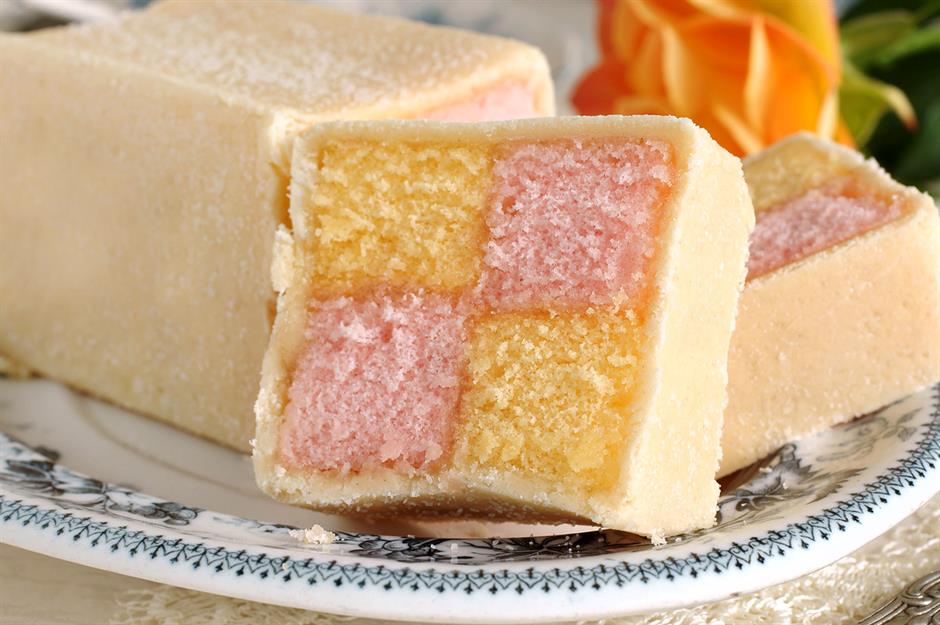
Few things evoke nostalgia for a Brit quite like a slice of Battenberg cake. Said to have been created to celebrate the 1884 marriage of Prince Louis of Battenberg and Princess Victoria, this iconic treat features a simple sponge with colourful chequered sections, all wrapped in a delicate layer of marzipan. It’s the perfect accompaniment to a traditional afternoon tea.
57. Shoofly pie
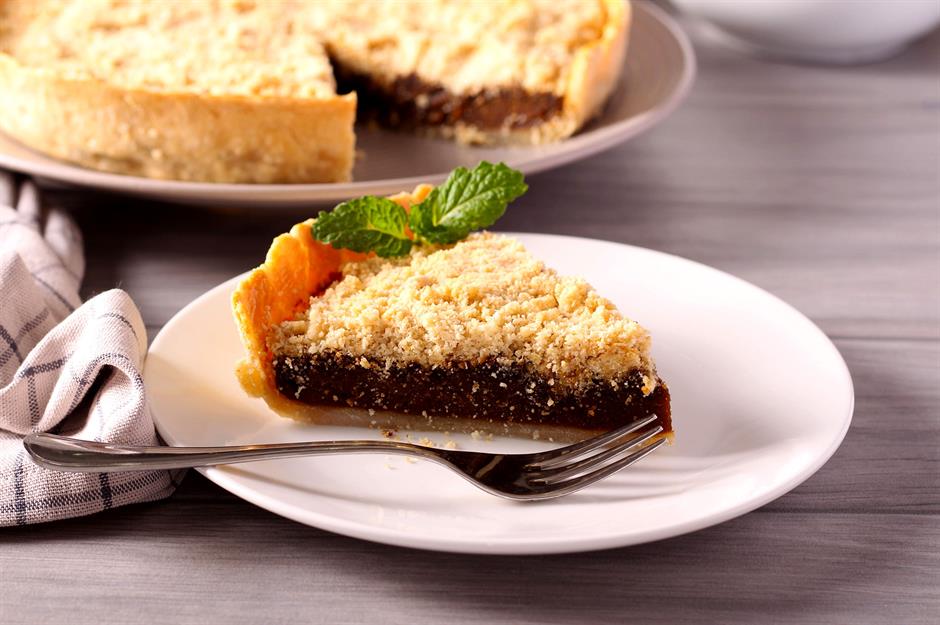
A pretty niche American dessert, shoofly pie is believed to have been developed by the Pennsylvania Dutch in the 19th century and consists of molasses, brown sugar and cinnamon, encased in a flaky crust. What's not to like, right? This pie has been relegated to the past now, but we think it's worthy of reassessment.
56. Porcupine meatballs
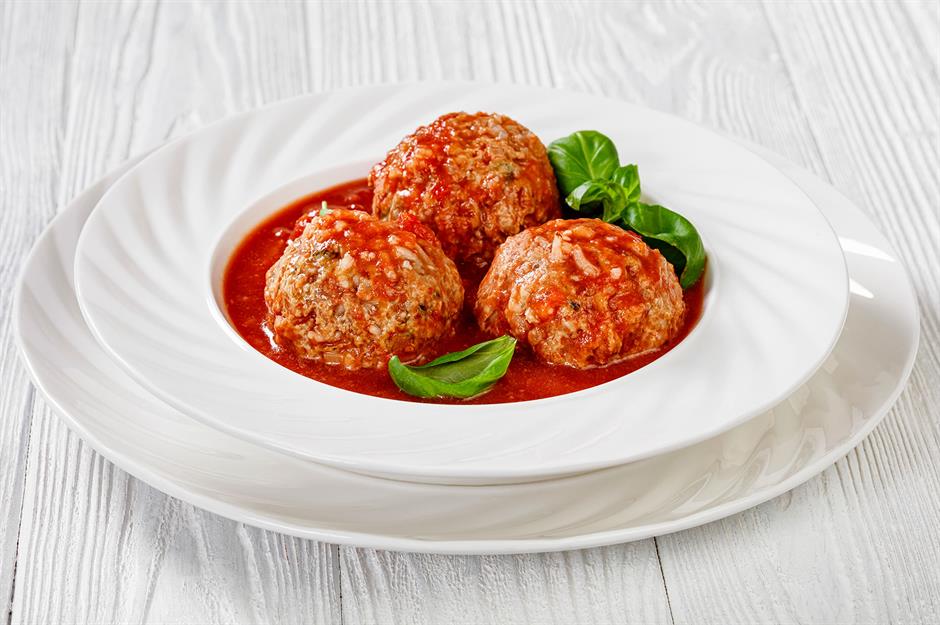
Don't worry: no porcupines are harmed in the making of this dish. It's so-called because the meatballs are studded with long-grain rice to give the dish its signature look and taste. The recipe is a product of its era – the early 20th century – when people had to find creative ways to make their meat go further. We think these saucy meatballs are ripe for rediscovery in restaurants and homes around the world.
55. Liver and onions
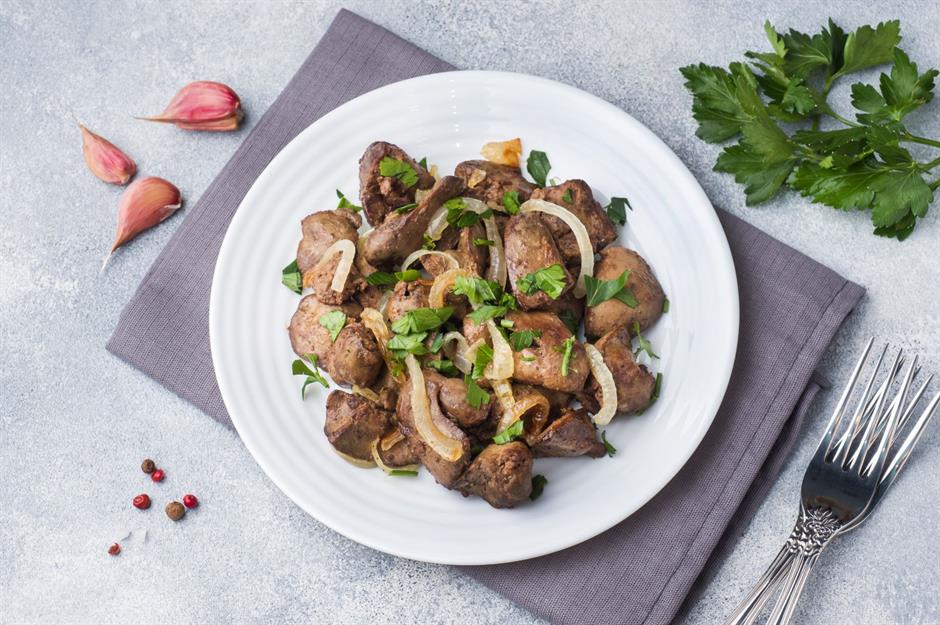
If you grew up in the mid-20th century, you might recall being served bland, overcooked liver with stringy onions week after week. Quick, easy and affordable, it was also one of the dishes most children dreaded. Done properly, however, liver and onions can be a genuinely delicious meal – so it's definitely deserving of a well-earned revival.
54. Tunnel of fudge cake
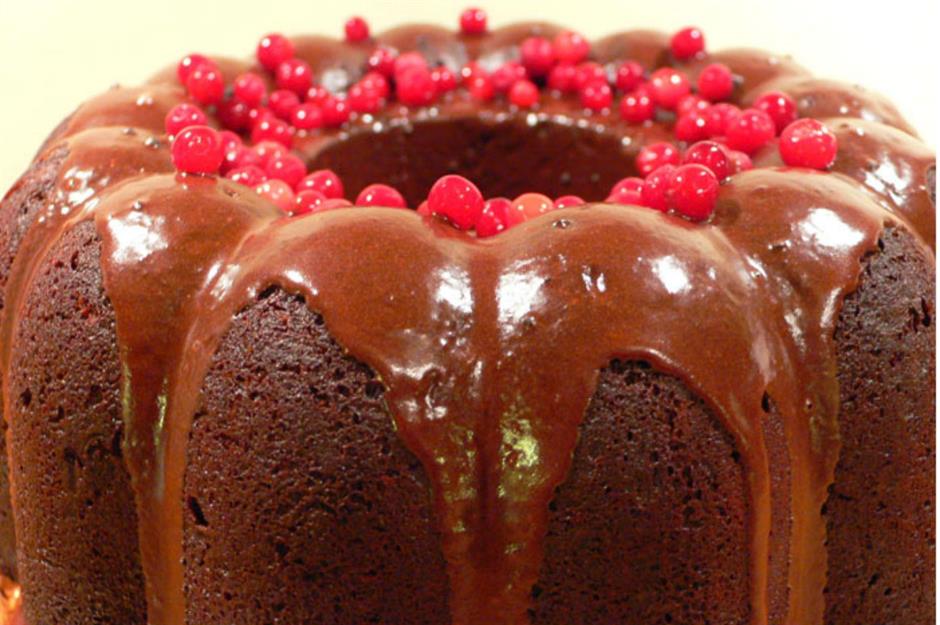
The tunnel of fudge cake is a rich chocolate and nut bundt cake with a fudgy tunnel running through the centre. It was introduced in 1966, when it won second prize at the USA's Pillsbury Bake-Off Contest. Despite losing to Golden Gate Snack Bread, it became Pillsbury’s most-requested recipe and single-handedly brought bundt cakes into fashion. If you like the texture of gooey brownies, you’ll love this.
53. Seven-layer salad
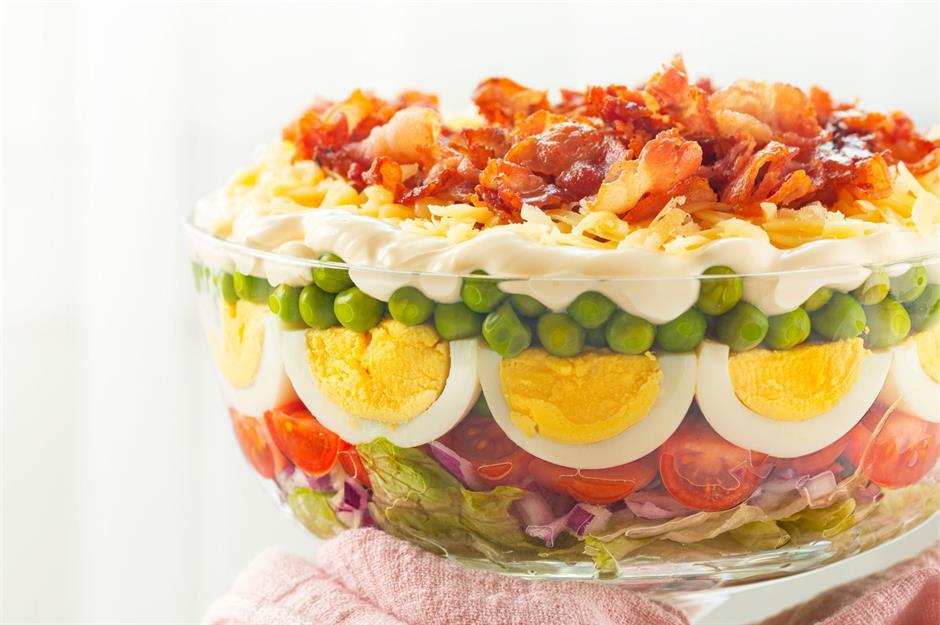
Can you remember a time when every buffet and barbecue table was brimming with glass bowls of this unconventional salad? It was a popular sharing side in America during the 1950s and featured a rich, creamy dressing piled onto seven layers of salad ingredients. The components varied from bowl to bowl, but you could expect the likes of shredded lettuce, sliced onions, cubed tomatoes, hard-boiled eggs, crispy bacon bits, grated cheese and thawed frozen peas (yes, really). It’s not as popular today as it once was, but we’d happily welcome it back.
52. Tunis cake
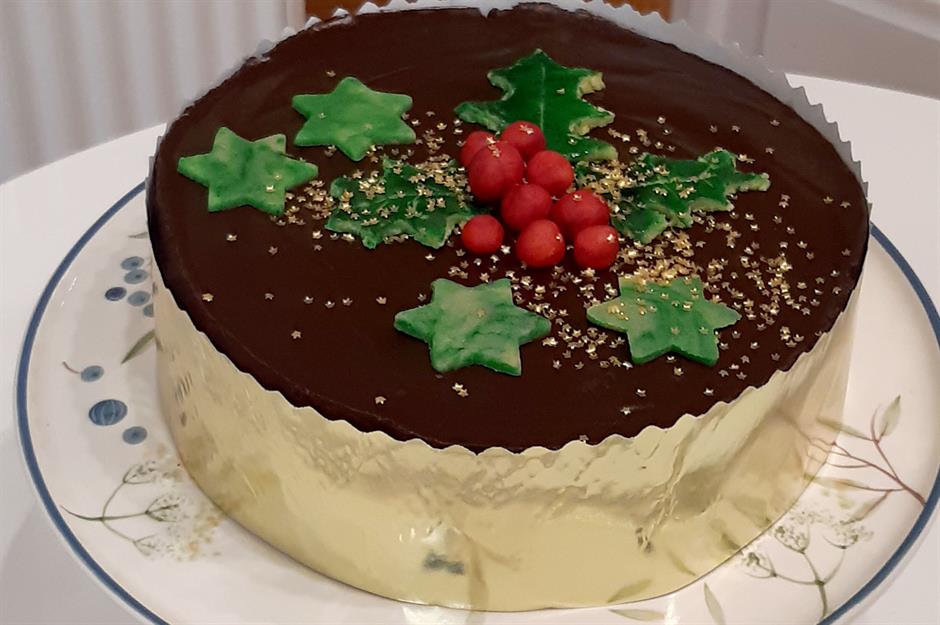
If fruit cake isn’t your favourite at Christmas, why not try a Tunis cake instead? This indulgent treat features a thick Madeira sponge topped with a generous layer of chocolate and festive marzipan decorations. Believed to date from the Edwardian era, it enjoyed peak popularity in Britain between the 1930s and 1980s. Fans were especially delighted when Tunis cake reappeared on the shelves of a popular supermarket in 2024 – perhaps signalling a full-blown comeback is on the horizon.
51. Semolina pudding
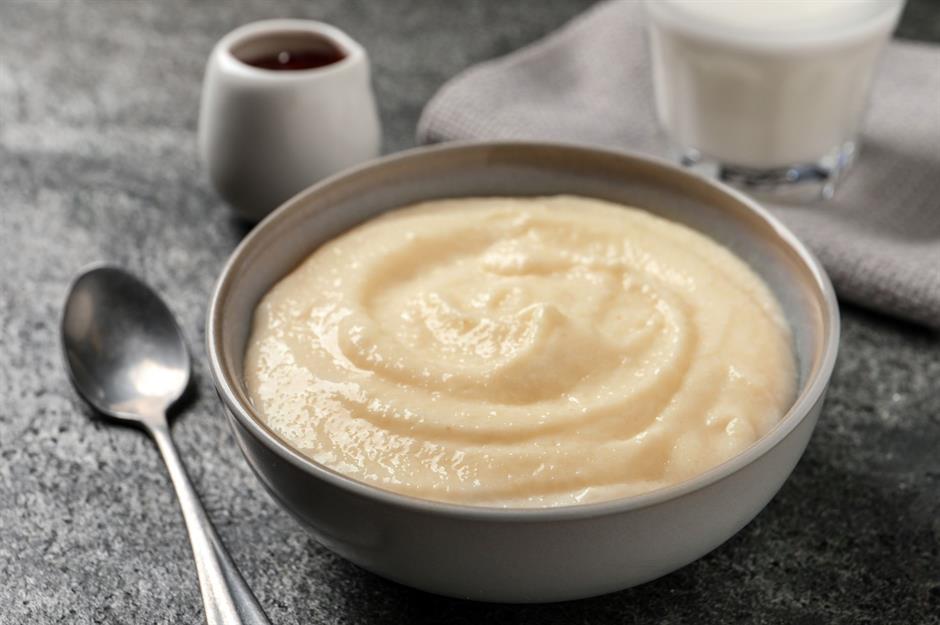
Served in schools across Britain from the 1950s onwards, semolina pudding hasn't always been a favourite with children, despite its creamy texture. Similar to porridge, it's made by gently heating dried semolina with milk, and it's typically topped with a sprinkle of sugar and cinnamon or a spoonful of jam. Though less common today, it remains a nostalgic dessert for those who grew up enjoying it.
50. Ambrosia
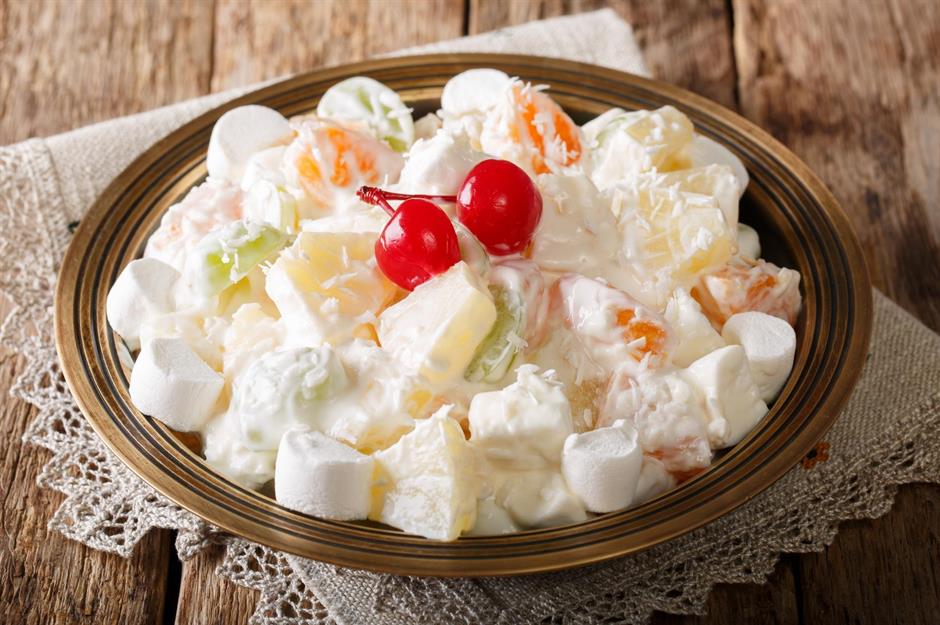
In the early 20th century, ambrosia fruit salad was ubiquitous at celebrations throughout the Southern United States. At its most basic, it's a combination of sliced pineapples and oranges, mixed with whipped cream – but there are many variations, including ones that use tinned fruit cocktail, marshmallows, maraschino cherries, bananas, strawberries, grapes, yogurt or cream cheese. It was once a luxury dish, and while nowadays the dessert is far from upmarket, it still makes a quick and tasty treat.
49. Anything in aspic

Freezing pretty much anything in aspic was a huge trend in the mid-20th century, when savoury jellies were hugely popular. Brands such as Knox Gelatine and Jell-O launched marketing campaigns that had us setting every meal, from tomato soup to cheese, in gelatine. Some are now saying the time is right for an aspic revival – and we can definitely imagine this visually striking cuisine wobbling its way back to popularity.
48. Blancmange
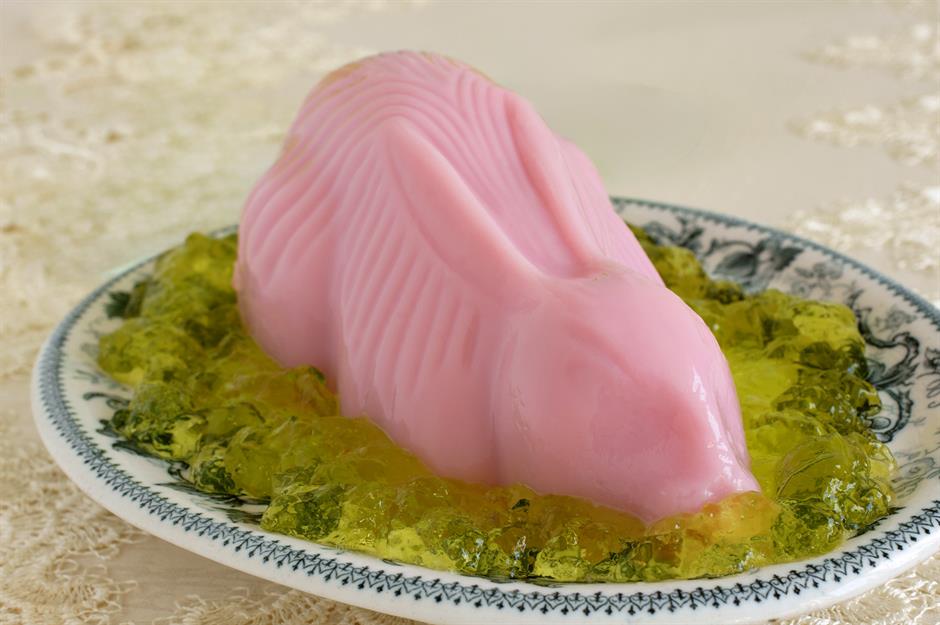
Thick and creamy, blancmange is a gelatine-based dessert that was popular throughout the 20th century. British brand Pearce Duff had four pale, opaque flavours to choose from: strawberry, raspberry, chocolate and vanilla. You could try reviving this classic with fresh raspberries, raspberry liqueur, double cream, ground almonds and rose petals – although we still think it would be fun to put it in a novelty mould.
47. Tuna noodle casserole
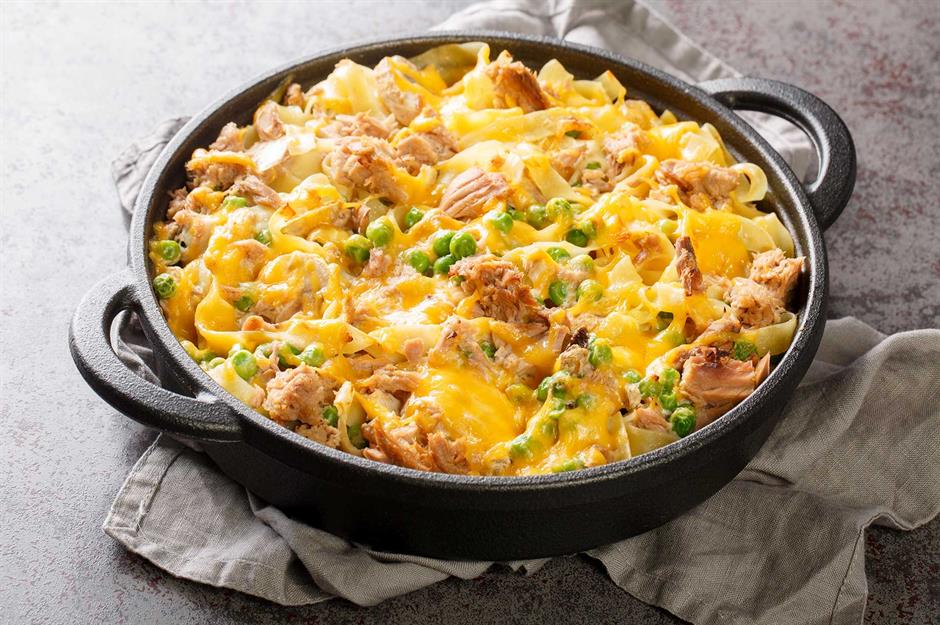
Tuna noodle casserole was once a regular midweek fixture, whipped up using pantry staples and canned goods. A mixture of pasta, Campbell’s cream of mushroom soup, frozen peas, tuna and breadcrumbs, it was a hearty dish that was as fuss-free as it was tasty. For a modern take on the recipe, try swapping canned soup for fresh chicken stock, butter and cheese, and top your casserole with panko breadcrumbs.
46. Salisbury steak
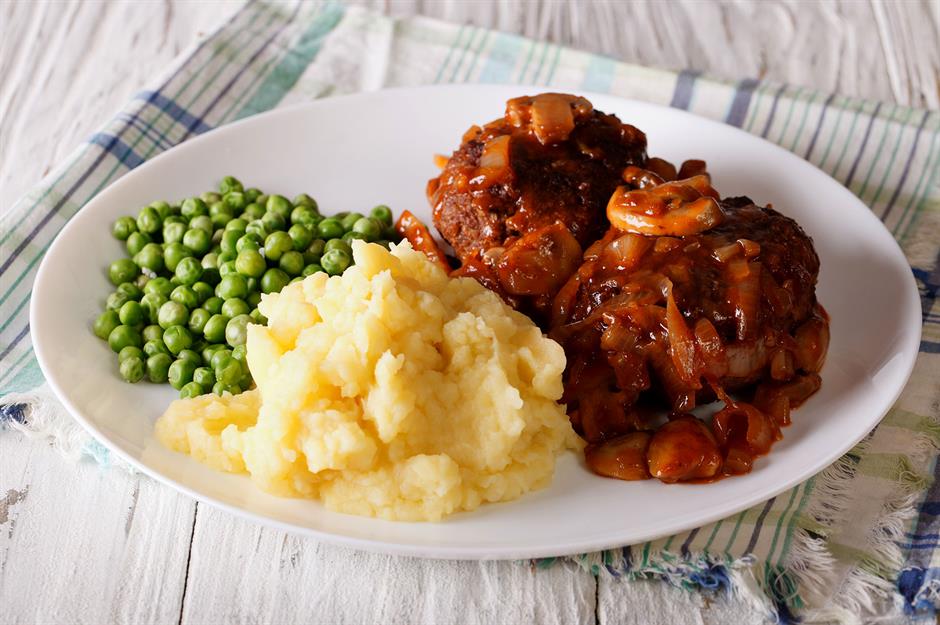
Made by shaping minced beef into miniature meat loaves, Salisbury steak – served with mashed potatoes and gravy – was a staple cafeteria lunch and TV dinner in America in the 1970s. It was invented at the end of the 19th century by an American physician, who intended it as a digestion aid. However, by the end of the century, it was regularly accompanied by tater tots, instant mashed potatoes and other convenience foods – so the 'healthy' tag was rather lost. You could easily give this dish a modern makeover with sweet potato mash and homemade onion gravy.
45. Tennessee onions
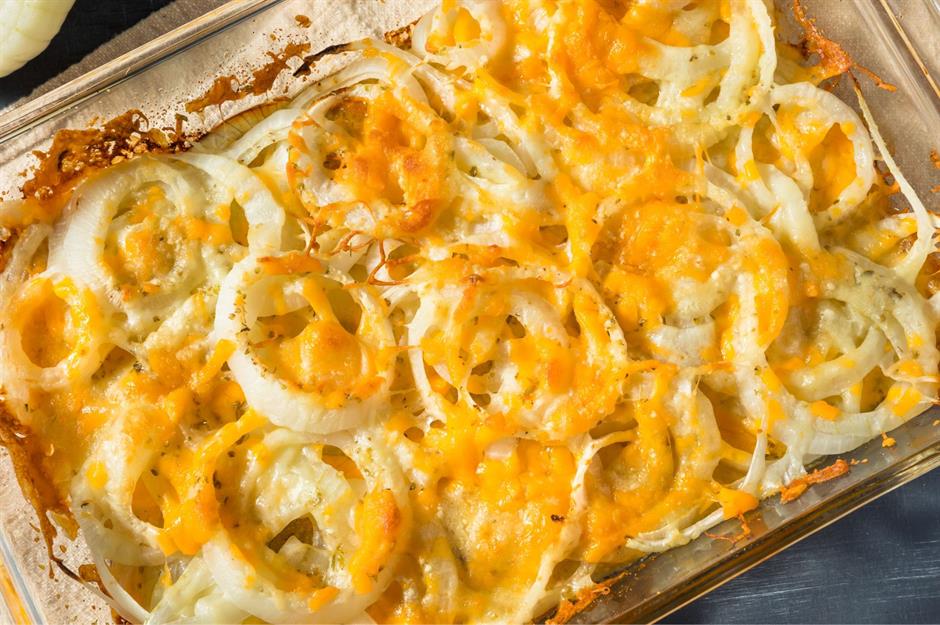
A beloved dish across America’s Southern States during the 20th century, this old-school casserole is thought to have originated in Georgia, despite its name. The comforting recipe layers thickly sliced onion rounds with spices, butter and a three-cheese blend – typically Cheddar, Parmesan and smoked Gouda. The result is a rich, creamy side dish that's perfectly balanced by the natural sweetness of the caramelised onions.
44. Popcorn salad
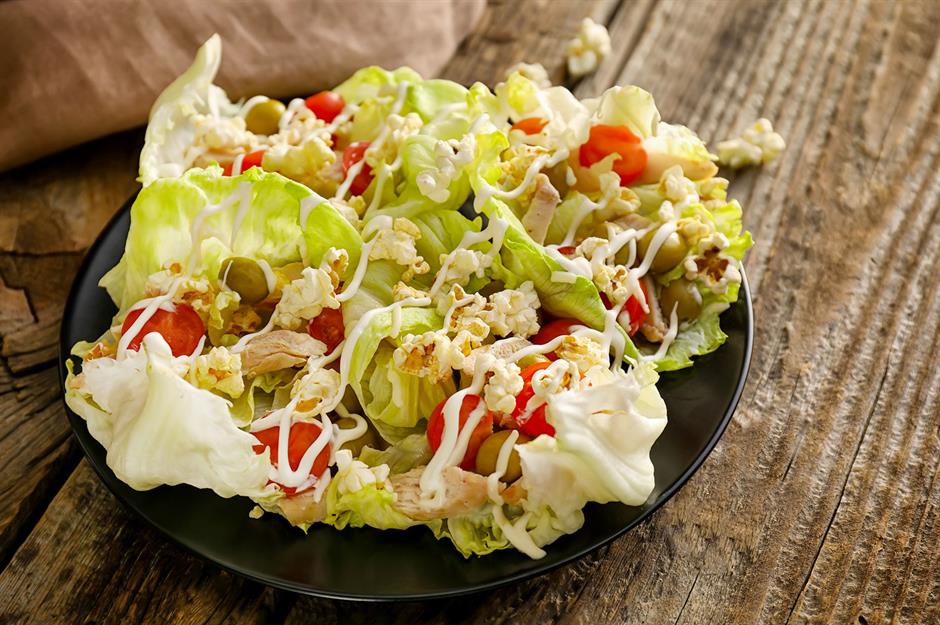
If this dish sounds familiar, it's because a version of it went viral on the internet in 2021, thanks to a Food Network recipe by cookbook author Molly Yeh. People couldn't wrap their heads around the thought of putting popcorn in a salad – but actually, the idea is nothing new. The dish is an old Midwestern one that's been around for decades. For those who love savoury snacks, it's certainly one way to make salads more tempting.
43. Sülze
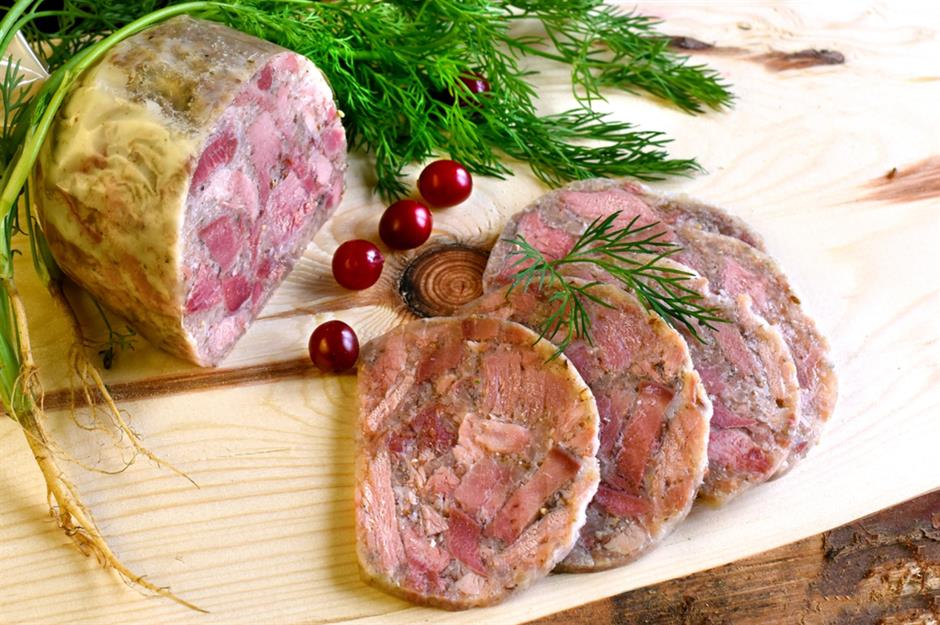
This one's perhaps not for the faint of heart – or the delicate of stomach – but many consider it a delicacy. A meat jelly made from the head of a pig or calf, sülze is a German variety of head cheese (also known as brawn). The aspic jelly has a vinegary taste and often includes different herbs and spices. We think it's a classic example of nose-to-tail cooking that deserves another chance.
42. Crown jewel dessert
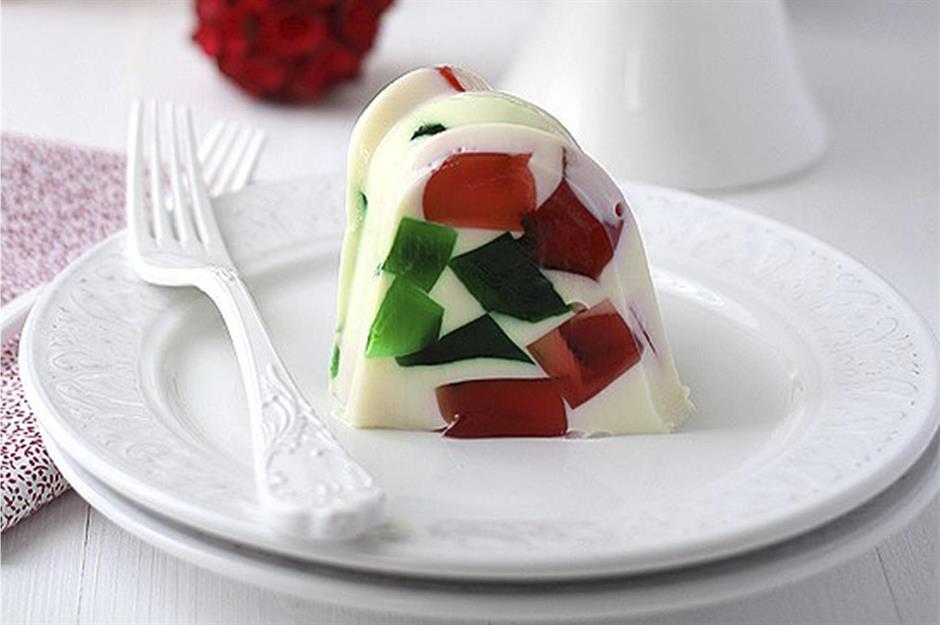
Crown jewel dessert, also known as broken glass cake, is without doubt a showstopping dish. The recipe was featured in a 1960s cookbook called Joys of Jell-O and calls for orange, cherry and lime Jell-O to be cut into cubes and folded into a thick lemon cream – made from lemon Jell-O and Dream Whip (a branded whipped cream). If you don't like Jell-O but want to recreate the look, give the Italian dessert semifreddo a whirl.
41. Stuffed celery
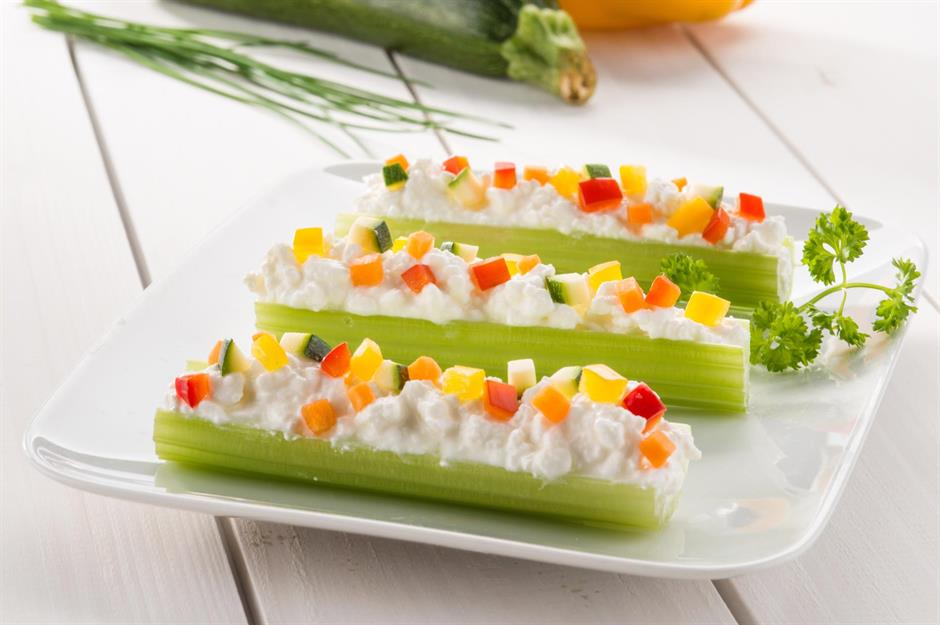
In the 1960s, a soirée simply wasn't a soirée without stuffed celery hiding somewhere on the buffet table. If you want to give it a go, pipe a filling of blue cheese, cream cheese, Worcestershire sauce and hot sauce into celery sticks. Garnish the celery with whatever you fancy; black olives, parsley, paprika and crispy chicken skin are all great choices.
40. Potato salad pie
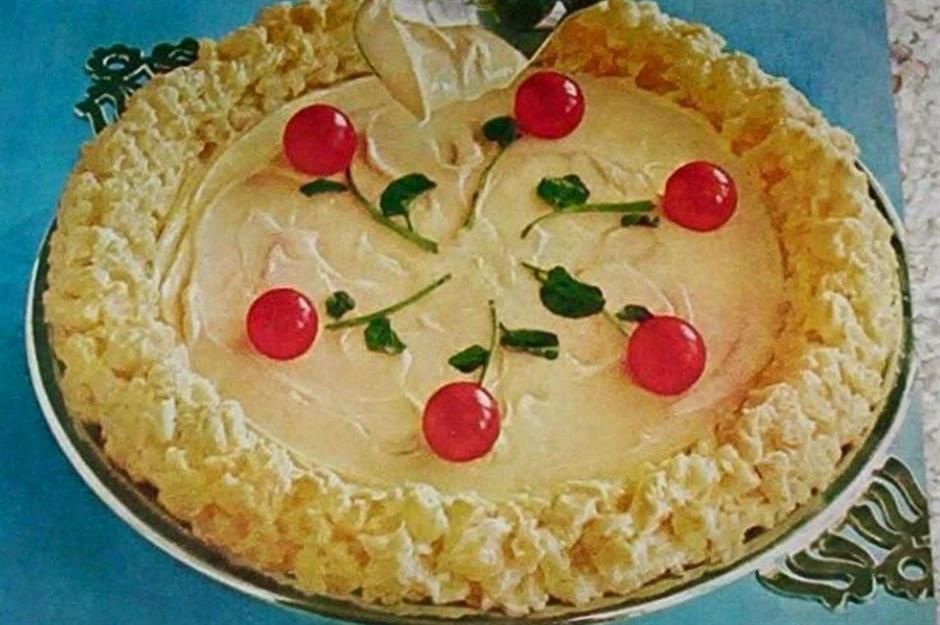
Back in the day, potato salad was a must-have dish when feeding a crowd – and this 1964 Hellmann’s Mayonnaise advert in Holiday Magazine showed a stylish new way to present it. Here, cooked potatoes, celery, onions and parsley are shaped inside a pie base, topped with a generous layer of mayonnaise and garnished with tomatoes and watercress. It's a carb-loaded treat we'd love to get our hands on today.
39. Labskaus
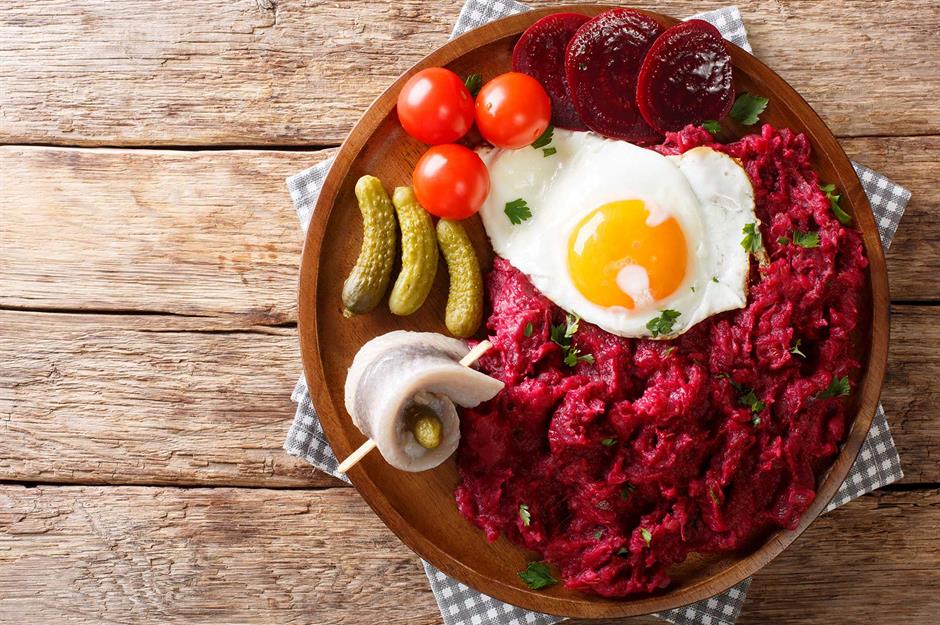
A traditional sailor's meal from northern Germany, labskaus consists of corned or salted beef mixed with potato, beetroot and onion, served with a fried egg, gherkins and rollmop herring. A version of the dish made its way to Liverpool, England, in the 18th century, where it became known as 'scouse'. This is apparently why Liverpool's inhabitants have the nickname 'scousers'.
38. Cheese cones
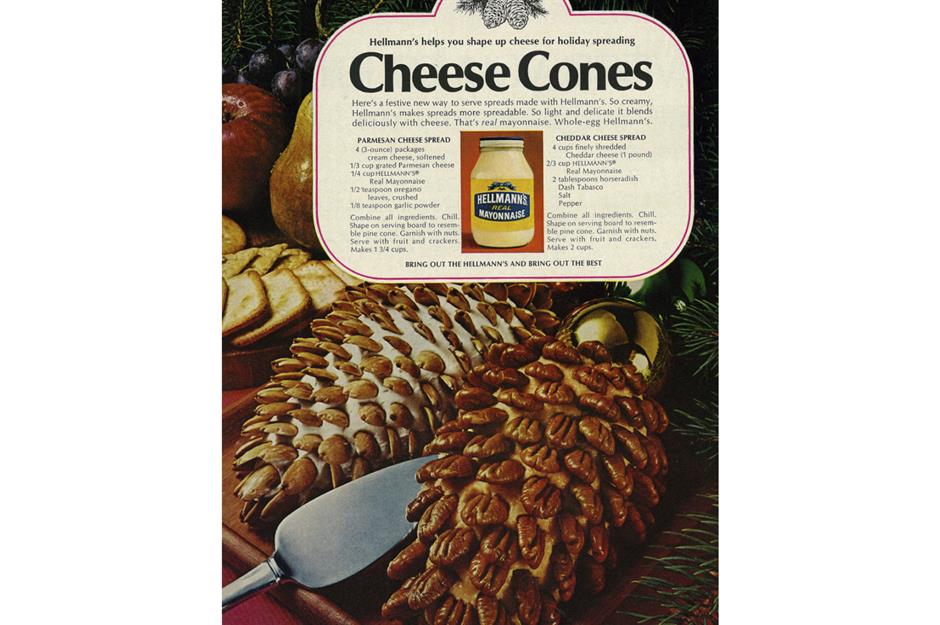
Cheese cones were a staple at Christmas gatherings in the 1970s. One recipe consisted of cream cheese, grated Parmesan, mayonnaise, oregano and garlic powder – while another featured shredded Cheddar, mayonnaise, horseradish and seasoning. They were shaped into logs and studded with almonds and walnut halves, so they resembled pine cones, and they were served alongside crisp Melba toasts and crudités.
37. Jell-O Under the Sea Salad
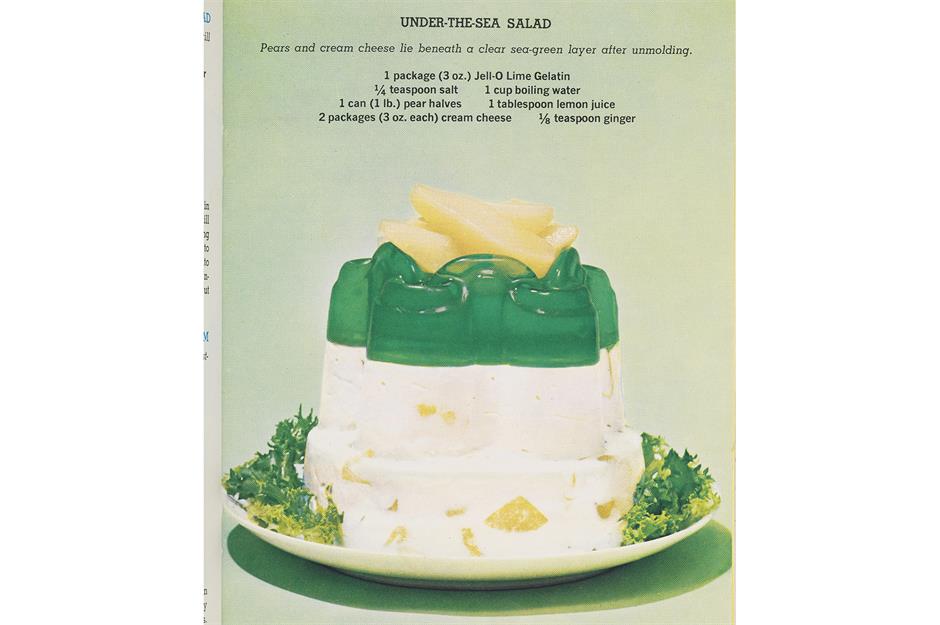
In mid-20th century America, neither Jell-O nor salads were exclusively sweet or savoury, and dishes like Under the Sea Salad found their place on the buffet table somewhere between the main dishes and desserts. A recipe for this dish was featured in the Joys of Jell-O cookbook. Consisting of a cream cheese and pear base topped with lime Jell-O, it doesn’t sound half bad – maybe just skip serving it on the bed of salad leaves.
36. Fruit cocktail pudding
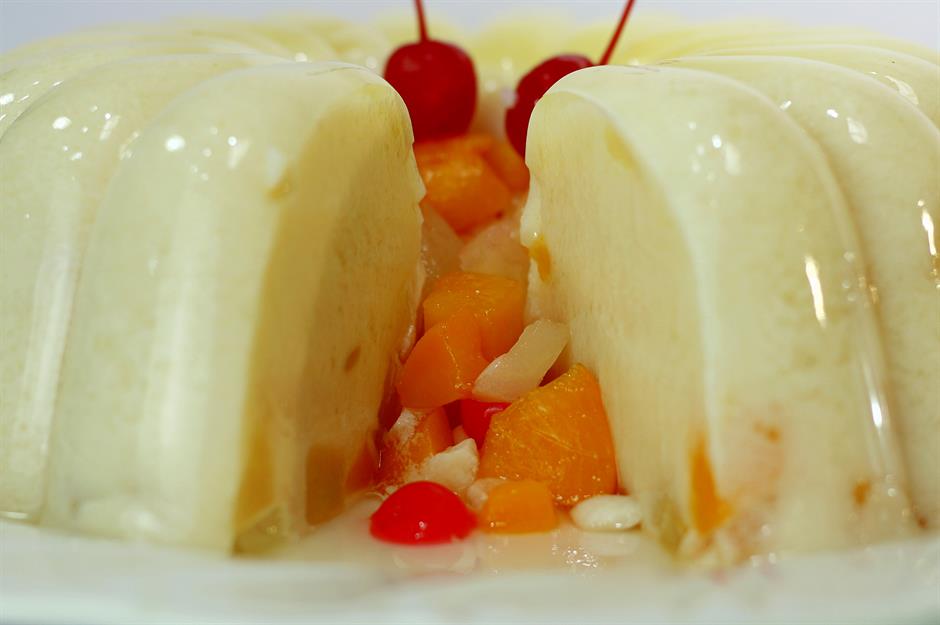
Combining pears, grapes, cherries and peaches (and later, pineapple), the tinned fruit cocktail took off around the 1930s. It was invented to stop the good parts of bruised fruit from going to waste, but clever marketing had us viewing it as a speedy and sophisticated dessert. A recipe from Jell-O in the late 1950s suggests alternating layers of vanilla pudding and whipped cream with the fruit mix in a dessert glass.
35. Cheese balls
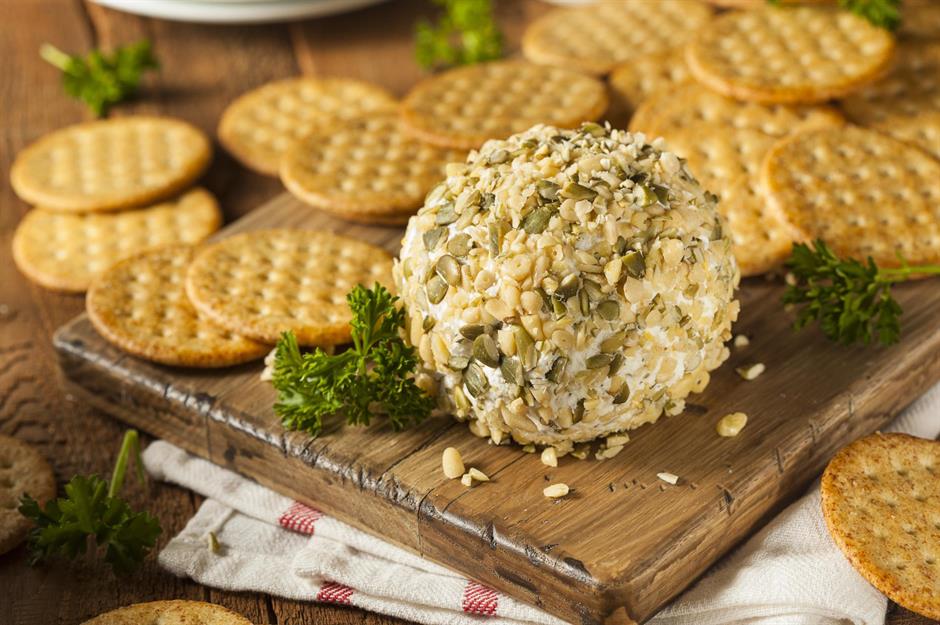
Look to the 1970s for party snack inspiration and whip up a trio of cheese balls for your next gathering. Blend cream cheese with blue cheese, Cheddar, pink salmon or crushed pineapple, shape into balls, then roll in walnuts, pine nuts and parsley – or make up your own recipe based on your favourite ingredients. You can prepare the balls ahead of time and store them in the fridge until your guests arrive.
34. Duchess potatoes
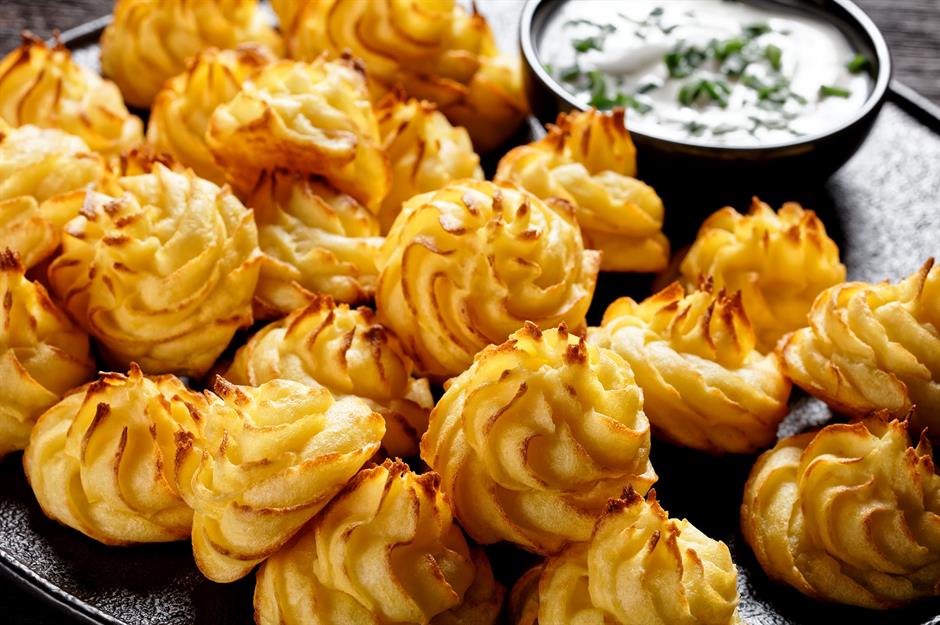
Duchess potatoes were the hottest side dish of the 1960s and 1970s. They're simple to make: roast Russet potatoes, pass them through a ricer, enrich them with egg yolk, butter and nutmeg, then pipe the mixture onto a baking tray. They’re traditionally shaped into little stars or spiral mounds, brushed with egg yolk, then baked until crisp on the outside and fluffy in the centre. Try serving them with roast beef as an alternative to roast potatoes.
33. Sauerbraten
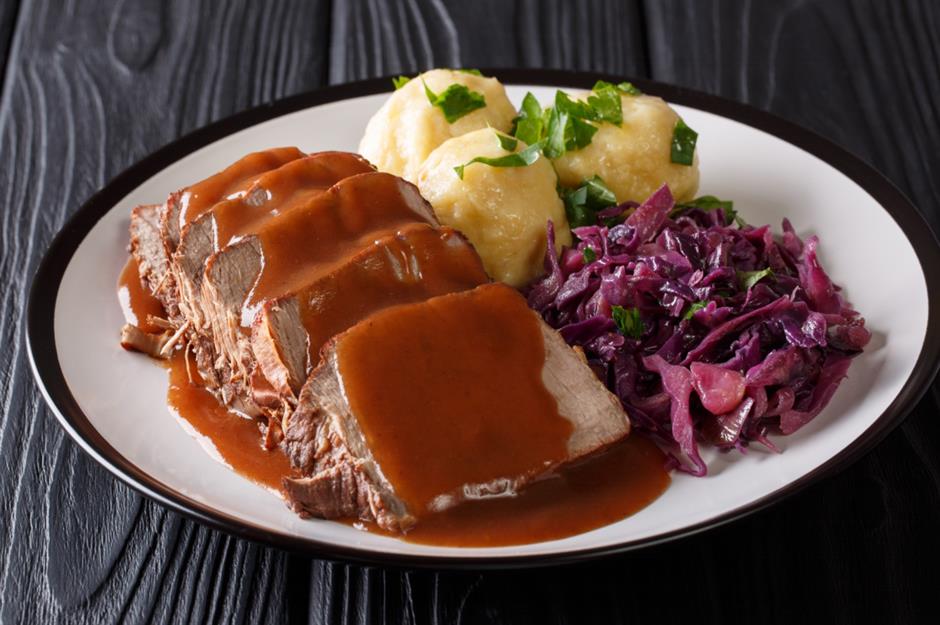
A national dish of Germany, sauerbraten dates back hundreds of years. It's thought to have lofty origins, with some believing medieval emperor Charlemagne invented it to use up leftover meat – and others crediting Julius Caesar himself. Translated into English as 'sour roast', sauerbraten is made by marinating meat for up to 10 days in a mix of wine, vinegar and spices. It's served with a sweet and sour gravy, often featuring crumbled-up ginger snap biscuits.
32. Ham in parsley aspic
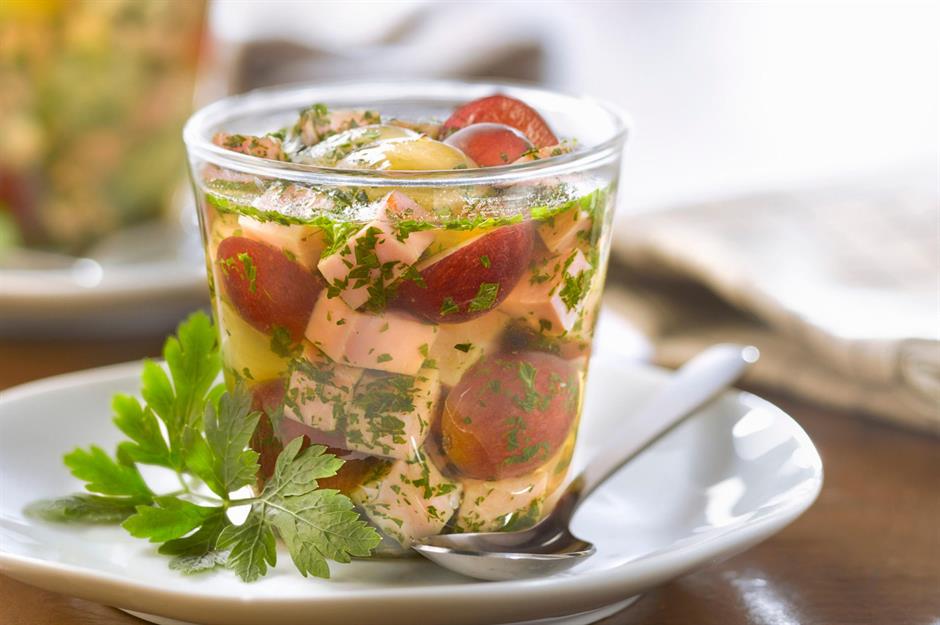
Food in the 1960s was heavily influenced by pioneering cooks such as Julia Child, who brought the joys of French-inspired cuisine to the masses. Jambon persillé en gelée – known in English as ham in parsley aspic – is a fine example. Bright green, with optional tomato roses or extra parsley sprigs on top, it may look unusual, but it's surprisingly delicious.
31. Quiche Lorraine
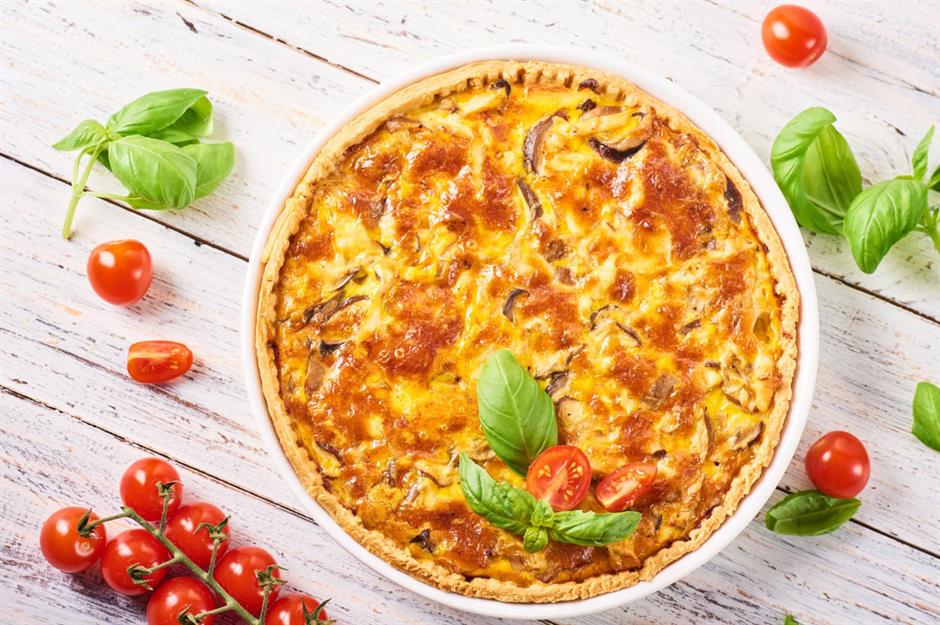
A recipe for quiche Lorraine appeared in Julia Child's 1968 cookbook, The French Chef Cookbook – and just like that, the cheesy, creamy delight became one of the most popular dishes around. Sumptuously rich and savoury, it contains crispy bacon lardons, Gruyère (or Emmental or Cheddar, if you prefer), eggs and cream, all bound together in a pastry case. We'd love to see it make a return to lunch tables soon.
30. Peach Melba
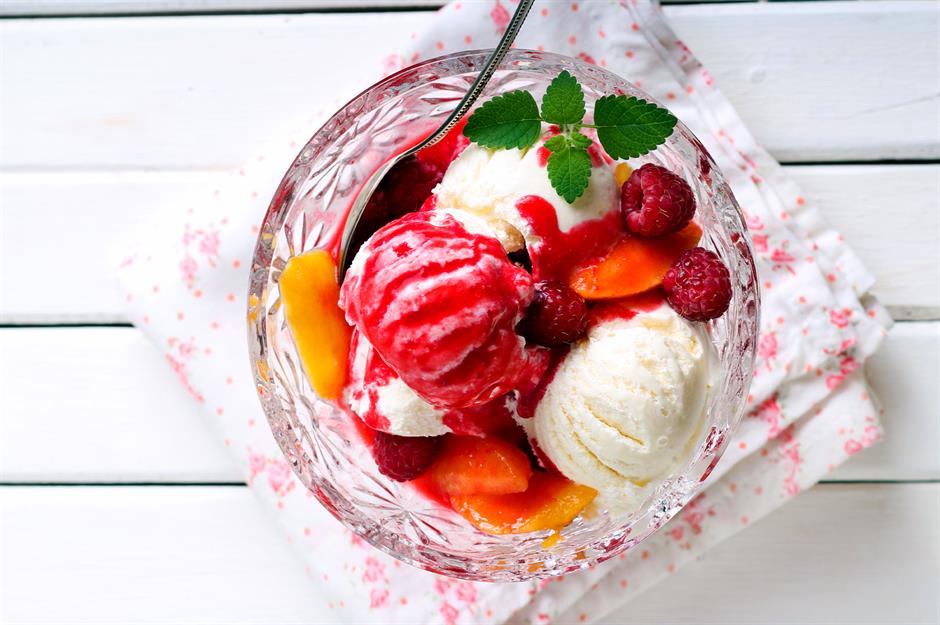
Peach Melba is a simple but rather beautiful dessert of sweet poached peaches and tart raspberry sauce, served with vanilla ice cream. Created by Auguste Escoffier at The Savoy in London at the end of the 19th century, it was named after Australian opera star Dame Nellie Melba. These days you’re unlikely to find it on dessert menus, but we think the simple combination of fruit and ice cream is timeless.
29. Apricot chicken
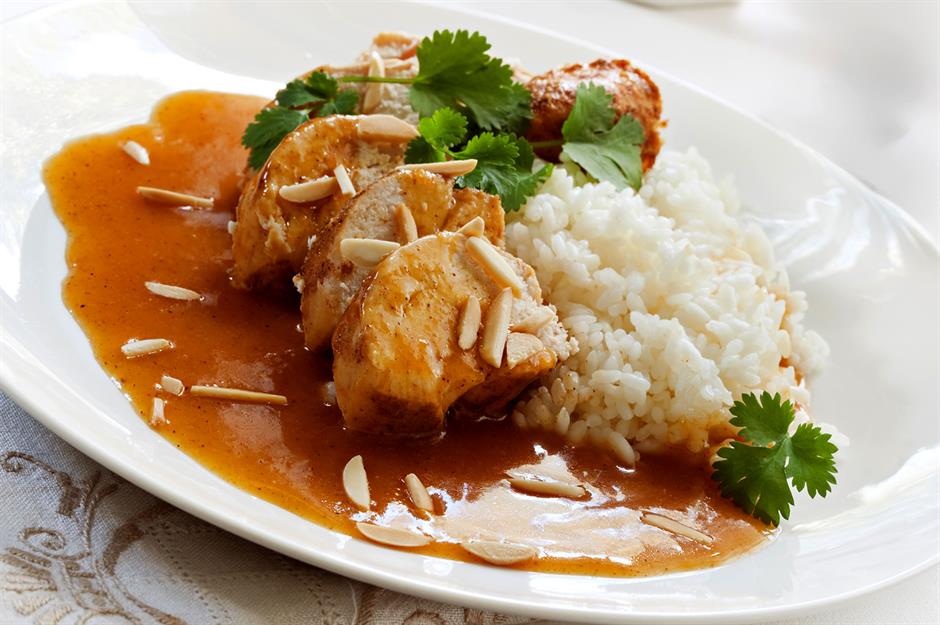
Satisfying and easy to make – with not too many ingredients required – apricot chicken was a staple in Australian households in the 1970s. Back in the day, it consisted of chicken legs and thighs with French onion soup and apricot nectar, poured over rice. Give it a new lease of life and make a Middle Eastern–style chicken and apricot tagine, with cinnamon, ginger, turmeric, almond slices and fresh herbs.
28. Toast Hawaii
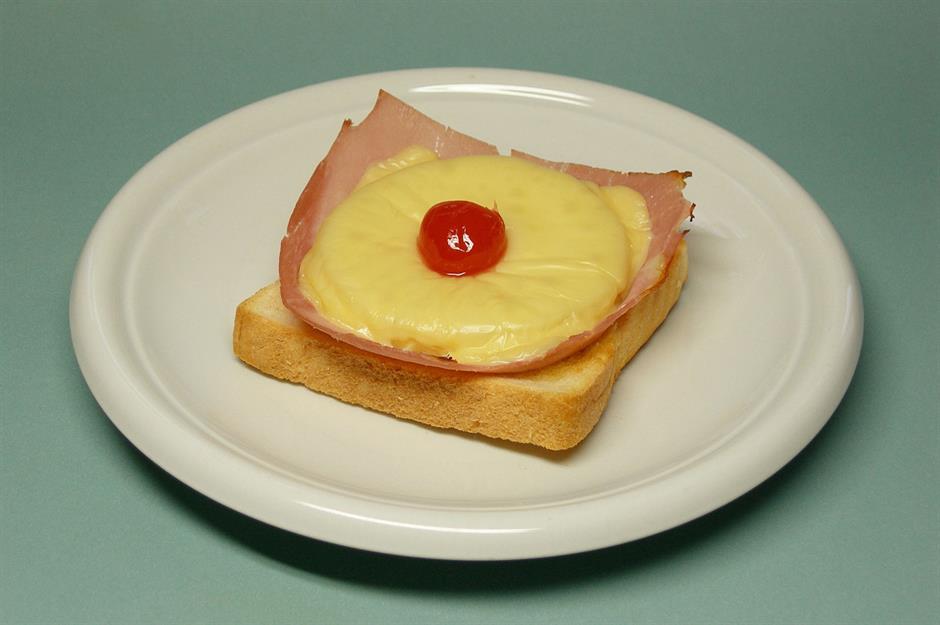
We all know how divisive ham and pineapple pizzas can be. But how about the same combo on toast, with melted cheese and a cherry on top? This unusual combination became popular in Germany in the 1950s thanks to TV chef Clemens Wilmenrod – and it was a common sight in the country's cafés and restaurants up until the 1980s. If Hawaiian pizza is still going strong, we think there's room for this dish to make a comeback too.
27. Charlotte Russe
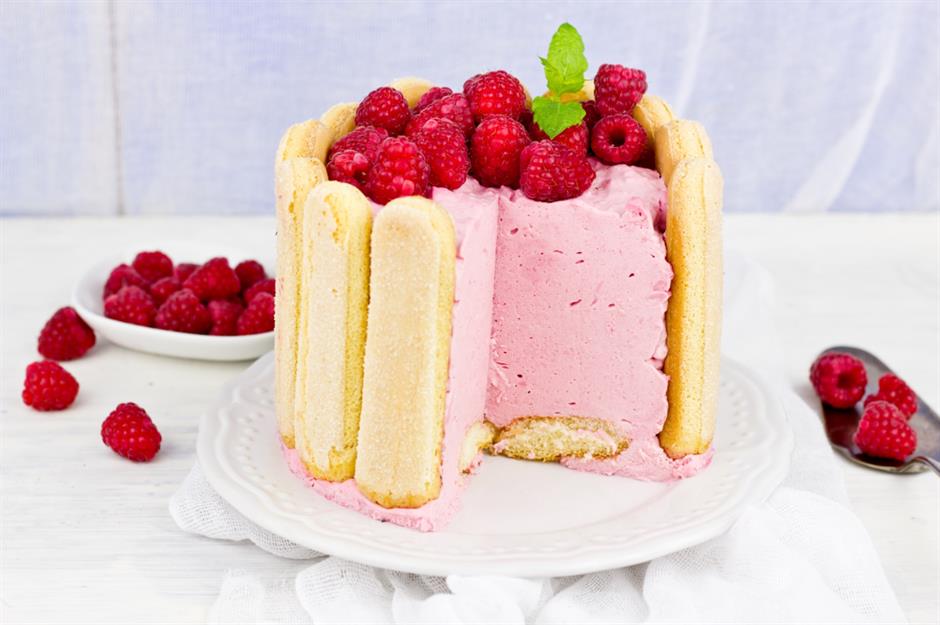
Invented in France in the 18th century, Charlotte Russe is a dessert that enjoyed renewed popularity in the early 20th century. Featuring a set cream filling, it was originally made by lining a cake mould with stale bread, but sponge cake or ladyfingers gradually became the favoured choice. Later, a simplified version – consisting of a thin square of vanilla sponge, a tall spiral of whipped cream and a maraschino cherry, served in a cardboard cup – became popular in New York's Jewish bakeries.
26. Bananas Foster
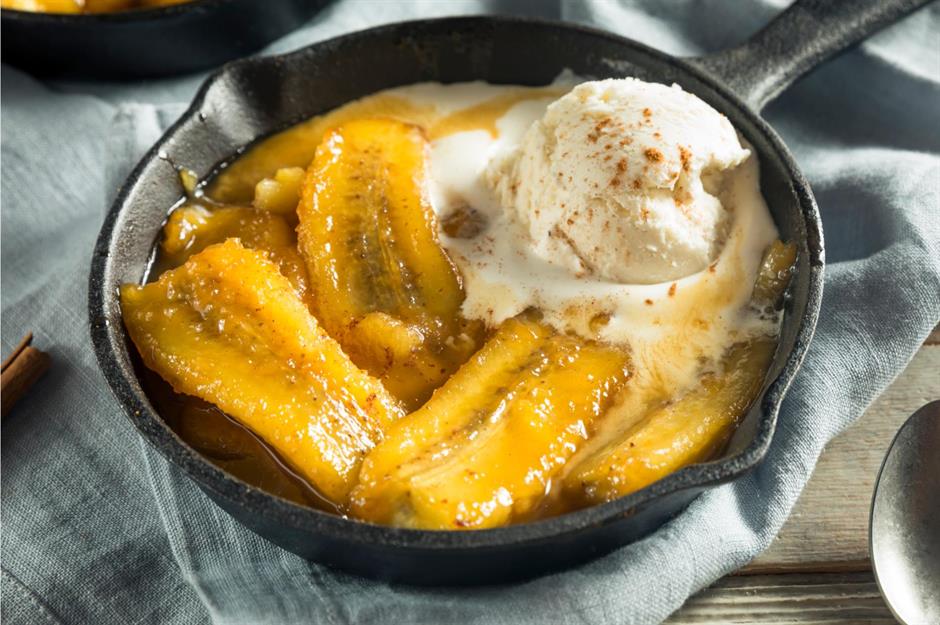
In the early 1950s, New Orleans was a major import hub for bananas, and the story goes that a chef at local restaurant Brennan’s was challenged to invent a dish using the fruit. His creation – bananas flambéed with brown sugar, butter, cinnamon, dark rum and banana liqueur, and served with ice cream – was a roaring success. Bananas Foster is still served at Brennan’s today, but we'd like to see it brought back everywhere.
25. Pineapple upside-down cake
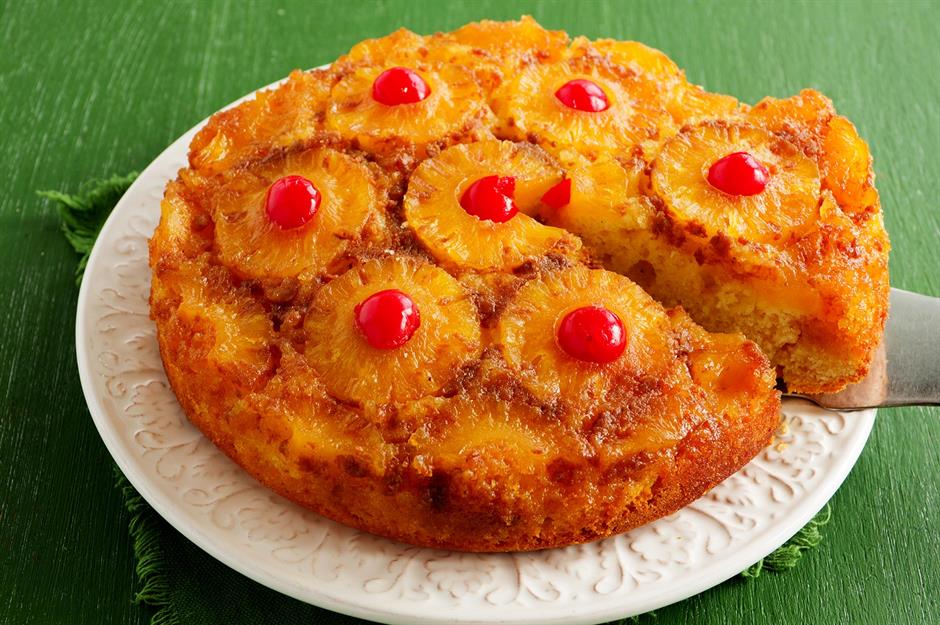
According to food historians, the term 'upside-down cake' first appeared in the late 1800s. However, it wasn't until the early 20th century that the pineapple upside-down cake began to pop up in magazines and cookbooks, following the introduction of canned pineapple. The dessert hit its peak in the 1960s and, while upside-down cakes are still around today, they're usually made using different fruit. We say bring back the retro appeal of the original, with whole pineapple rings and glacé cherries.
24. Chicken à la King
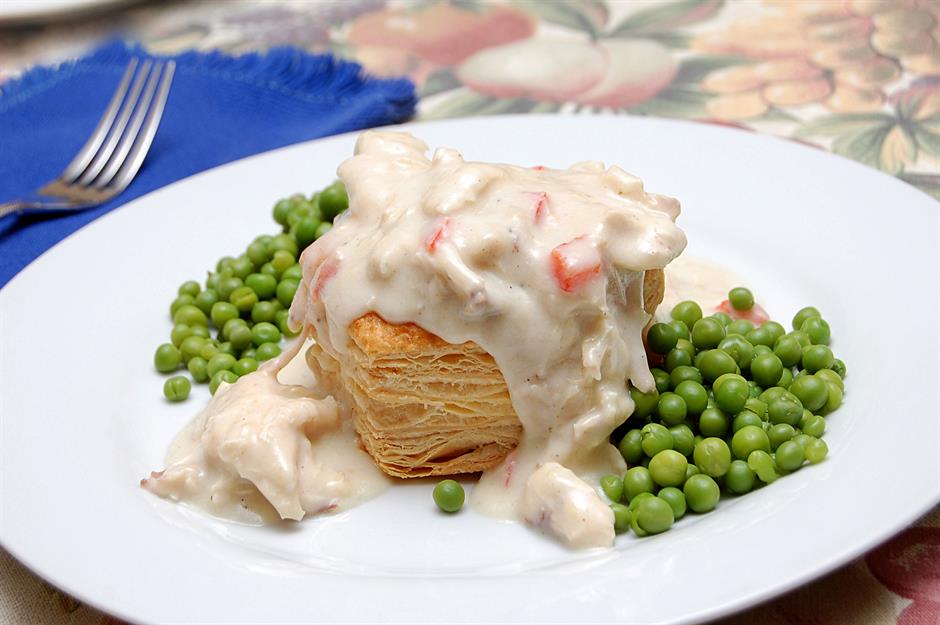
Invented at the start of the 20th century, chicken à la King became a popular wedding dish in the 1950s and 1960s. Written about by James Beard and The New York Times' Craig Claiborne, it reached its peak in the 1970s and 1980s, but it disappeared from most menus shortly after. To make it, chicken is cooked in a creamy sauce with mushrooms and peppers, then served with rice, pastry or toasted bread.
23. Lobster thermidor
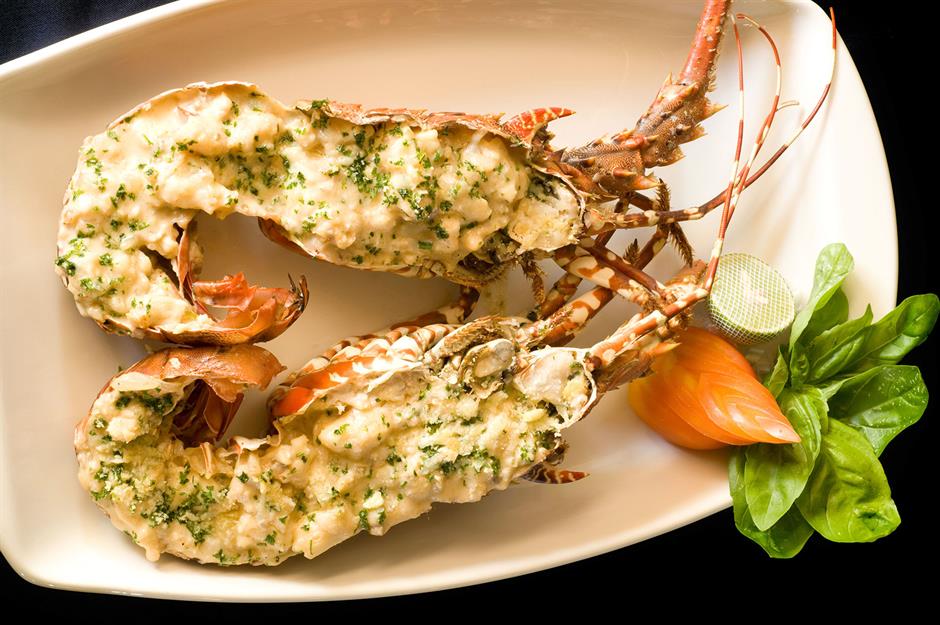
Lobster thermidor has been a French classic since its creation in 1894, celebrating the première of Victorian dramatist Sardou’s play, Thermidor. The dish sees succulent chunks of lobster tossed in a rich, indulgent sauce, returned to the shell, smothered with cheese, then baked until golden and irresistible. Perhaps the reason why lobster thermidor is no longer on so many menus is because the main ingredient is so expensive these days.
22. Jelly and ice cream

In the UK, no birthday party in the 1980s or 1990s was complete without a bowl of strawberry jelly, served with a scoop of vanilla ice cream. This childhood dish may not have been sophisticated, but it sure was delicious. We know it's all about fancy gelato flavours these days, but we think this simple combo is a classic that's worth revisiting.
21. Banoffee pie
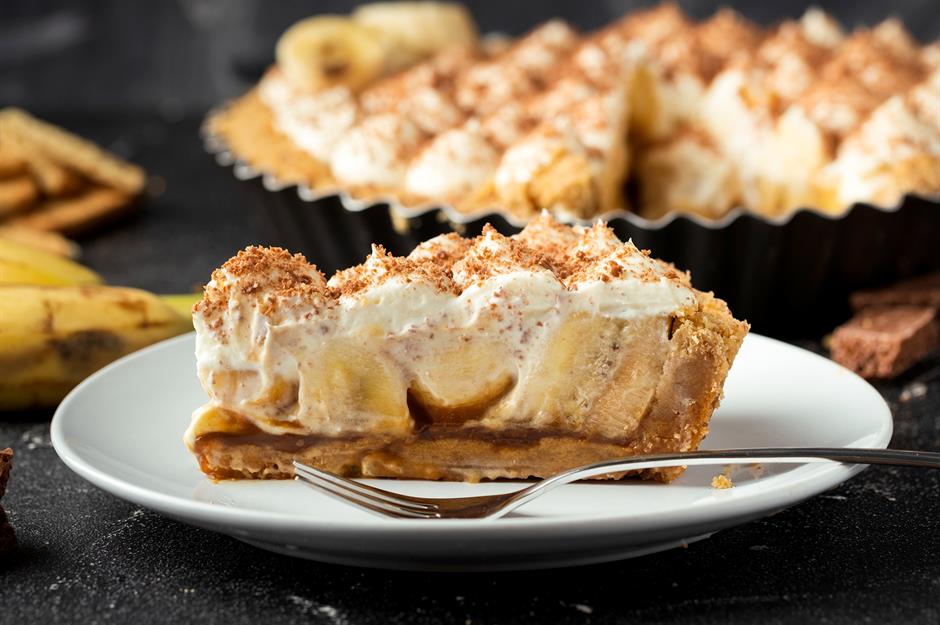
Despite its huge popularity in the US throughout the 1990s, this super-sweet, super-indulgent dessert was actually invented in England in the 1970s at The Hungry Monk Restaurant in East Sussex. A genius ensemble of gooey, sticky, creamy ingredients, banoffee pie sees sliced bananas, a toffee-like caramel sauce and whipped cream layered over a buttery biscuit base, then showered with chocolate shavings. Easy to make and deliciously decadent, it's still a fun treat to throw together at home.
20. Pasta primavera
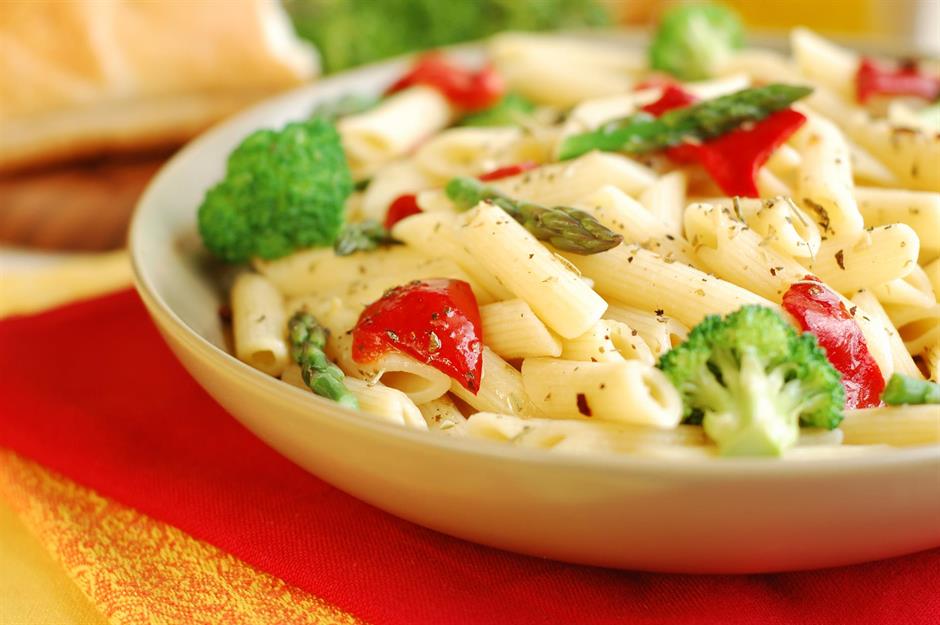
In the late 1970s, legendary New York restaurant Le Cirque popularised pasta primavera: a creamy pasta dish brimming with broccoli, courgette, asparagus and beans. The world has embraced lots of different pasta dishes since then, but this one's still a classic. Want to cook it at home? Simply make a sauce with butter, lemon and Parmesan, then throw in whatever cooked vegetables you feel like.
19. Chicken Tetrazzini
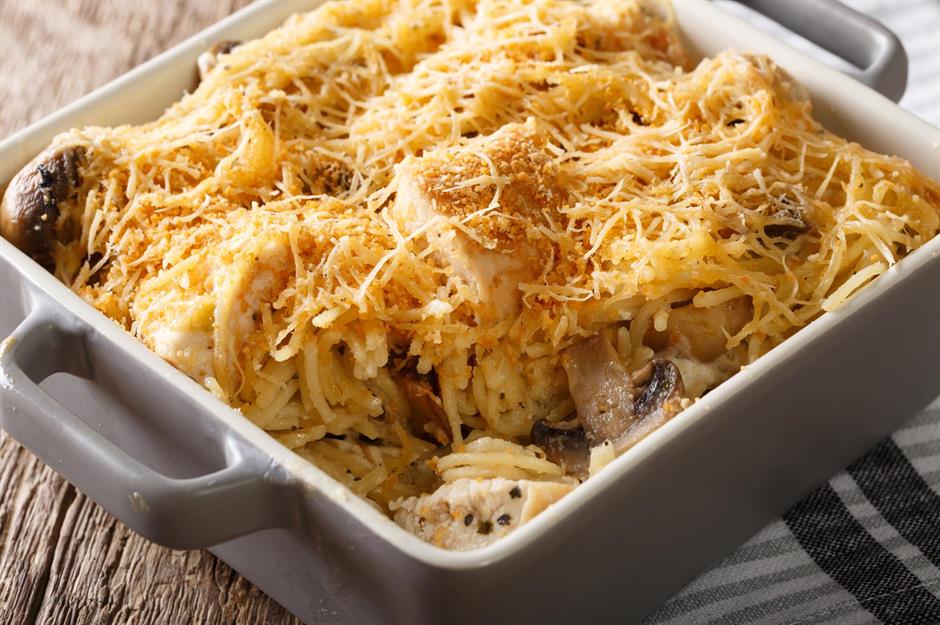
Chicken Tetrazzini was one of the most popular dishes in America for much of the 20th century. It’s widely believed that it was invented by a chef at a fancy San Francisco hotel, inspired by opera singer Luisa Tetrazzini. An extremely rich concoction of chicken, mushrooms, Parmesan and cream sauce, it's baked in a casserole dish until golden on top. By the second half of the century, it was a shadow of its former self, as home cooks replaced fresh ingredients with tinned versions. Bring back the original, we say!
18. Surf and turf
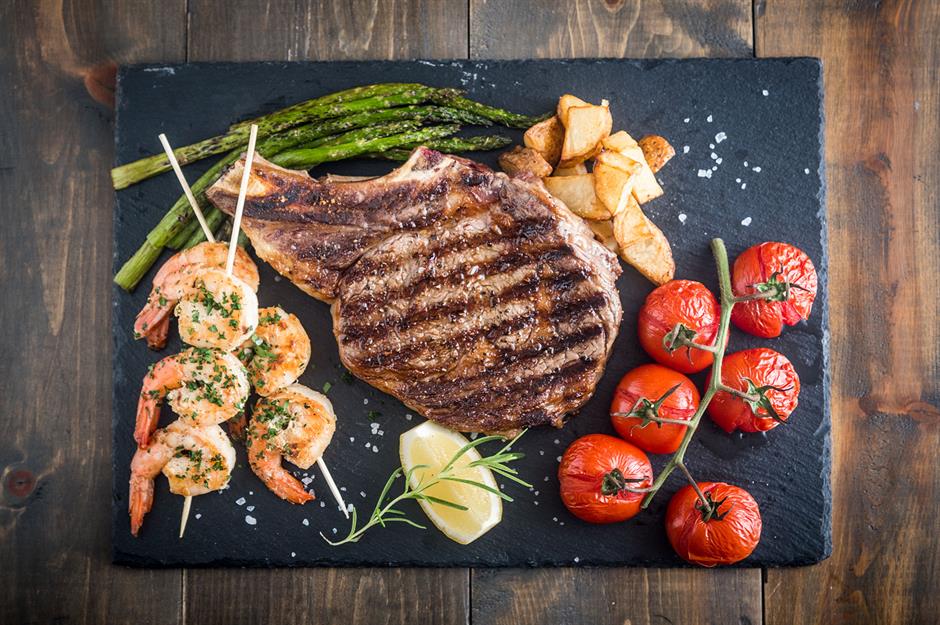
Back in the 1960s, surf and turf was a staple dish at steakhouses and sophisticated restaurants, where it was often the most expensive dish on the menu. A decadent platter of red meat (usually steak) and seafood (perhaps lobster or prawns), it combined two pricey dishes in one, so it was the dish if you wanted to show off. Want to get a taste of this indulgent pairing without feeling like you've stepped back in time? Try a surf and turf burger: a beef patty topped with prawns, all slotted into a bun.
17. Spaghetti casserole
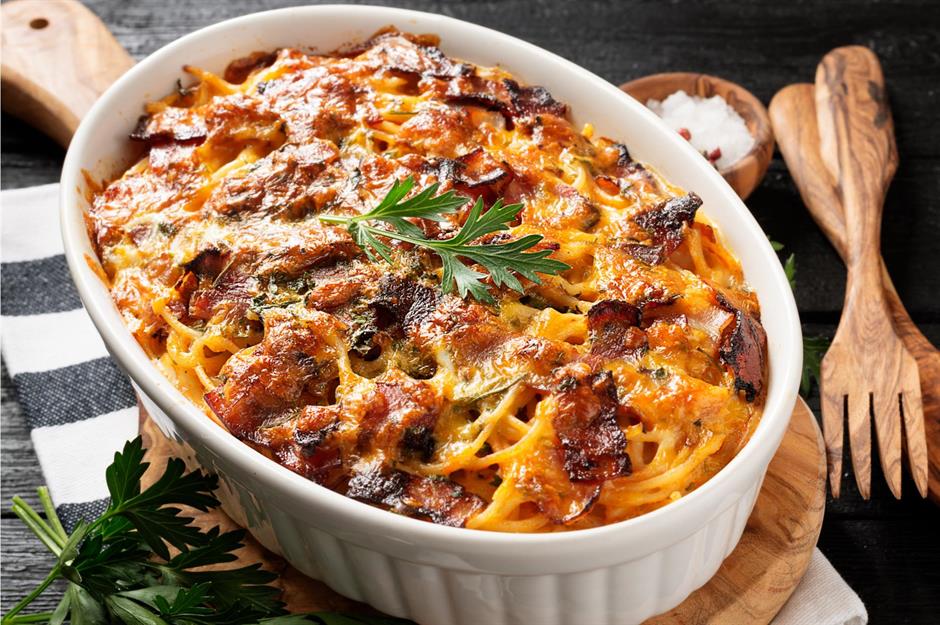
The 1950s saw an explosion of budget-friendly, filling and easy-to-freeze casserole dishes that were a great way to recycle leftovers and stretch them into a second meal to feed the family. Spaghetti casserole was a go-to option, with layers of spaghetti, minced beef, vegetables, tinned soup and grated cheese. Why not try resurrecting the recipe for a different take on spaghetti Bolognese?
16. Cherries Jubilee
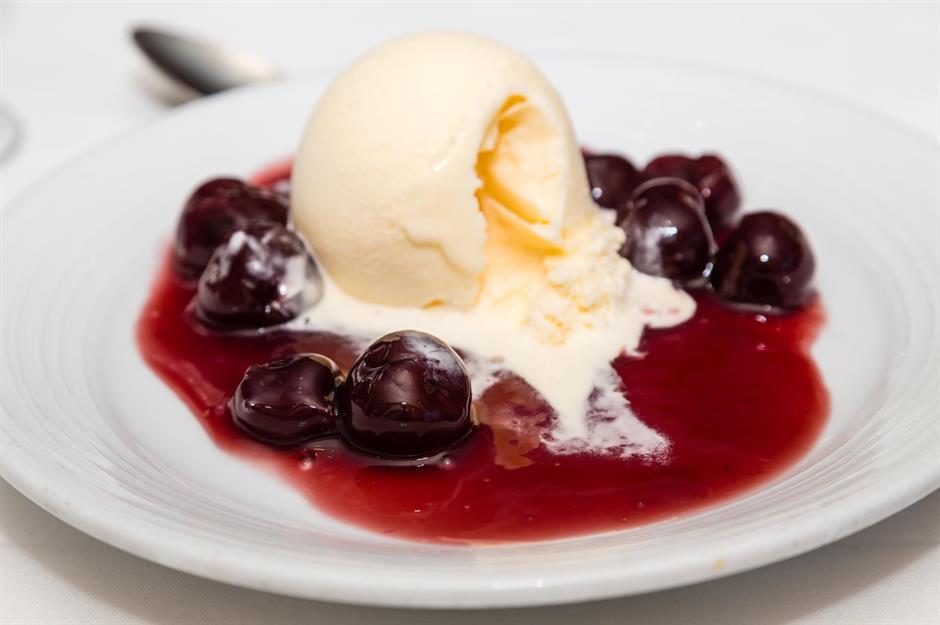
Cherries Jubilee is a theatrical dish that's generally credited to Auguste Escoffier, who is said to have created the dessert for Queen Victoria’s Golden Jubilee celebration in 1887. To make it, whole cherries are cooked in liqueur, flambéed and served with vanilla ice cream. Cherries Jubilee hit its peak in the 1950s and 1960s, when home cooks wowed their guests by making it a spectacular dinner party finale. It may have fallen out of favour, but we think it still makes a wonderfully rich, tasty dessert.
15. Cheeseburger pie

If you can't decide between a cheeseburger and a pie, why not have both? The genius cheeseburger pie became popular in the 1970s, all thanks to a Betty Crocker recipe. Consisting of a mixture of minced beef, onions, ketchup, mustard and Worcestershire sauce, this hearty dish comes layered with classic burger ingredients such as tomato, gherkins and, of course, cheese. What's not to love?
14. Devilled eggs
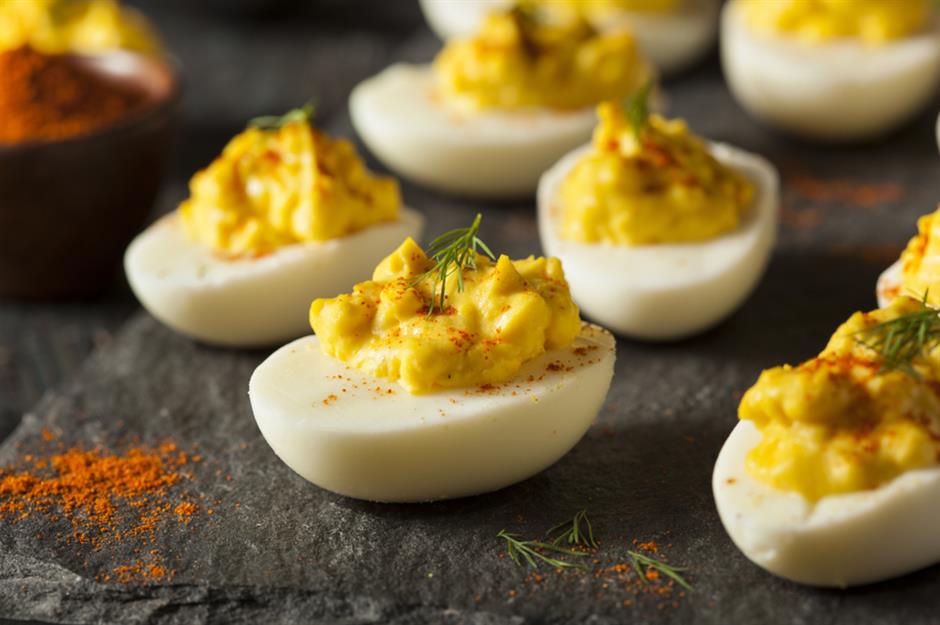
A staple of the 1970s dinner party scene, devilled eggs are too cute not to have a revival. A little fiddly to make (but totally worth it), they involve scooping the yolks from hard-boiled eggs, mixing them with mustard, mayonnaise, paprika and sometimes other ingredients, then piping the mixture back into the eggs. Delicate, tasty and crowd-pleasing, they're the perfect bite-sized canapés.
13. Crêpes Suzette
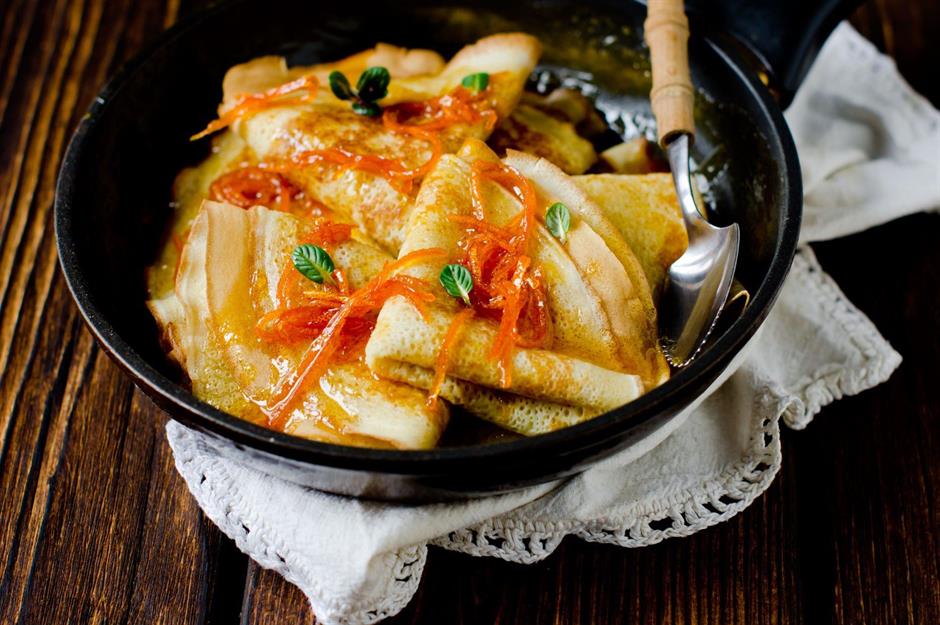
Desserts don't get showier than classic French dish crêpes Suzette. Traditionally prepared tableside at high-end restaurants by waiters in smart jackets, this spectacular dish sees pancakes doused in a mixture of caramelised sugar, butter, orange juice and orange zest, splashed with orange liqueur, then set aflame. It's now mostly relegated to the most old-school restaurants and retro-themed dinner parties. A word of warning if you do try this at home: make sure there's a fire extinguisher nearby!
12. Vol-au-vents
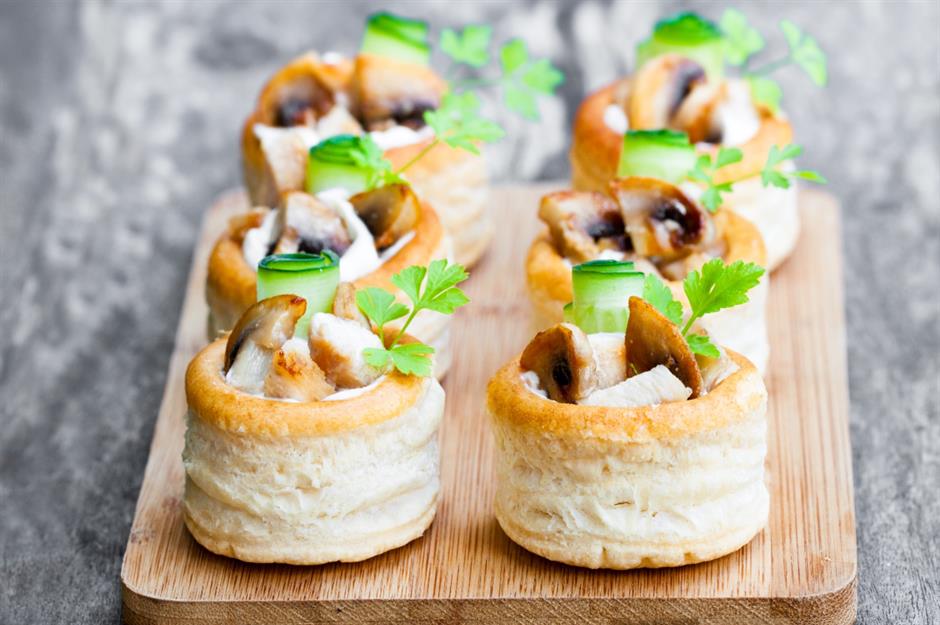
It was once the height of sophisticated hosting to fill puff pastry cases with cooked mushrooms, coronation chicken or prawn mayonnaise to create a platter of vol-au-vents. We think pastry-based starters or snacks should always be in fashion, so give this retro dish a makeover by updating the fillings. Pesto, hot smoked salmon and Stilton and mushrooms would all work perfectly.
11. Grape jelly meatballs
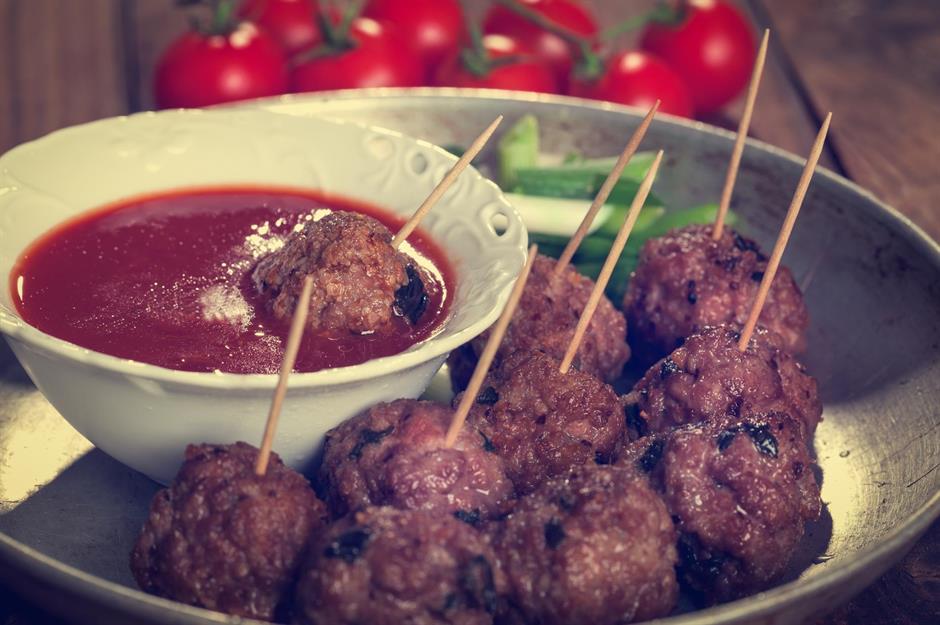
Old-school though they may be, grape jelly meatballs shouldn't be confined to the 1970s. To make these tempting appetisers, cocktail-sized meatballs (use shop-bought or make your own) are slow cooked in a sticky grape jam and chilli sauce mix. You could also add a pinch of paprika for extra smokiness, if you like.
10. Beef Stroganoff
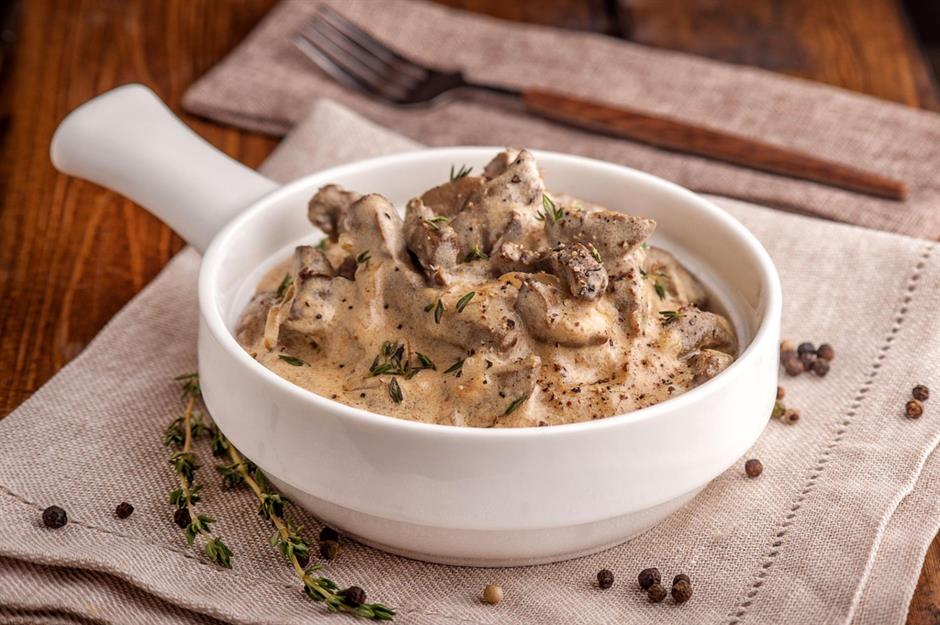
Named after Russian nobleman Count Pavel Stroganoff, this comfort food classic is said to have been invented by a French chef back in the 19th century – but it really took the world by storm in the 1960s and 1970s. Traditionally, it's made by coating sautéed beef in a sauce of mustard, onions and sour cream, but many 20th-century recipes introduced mushrooms to the mix. Made well (that's without the can of condensed mushroom soup), it's a recipe that's always worth revisiting.
9. Duck à l’orange
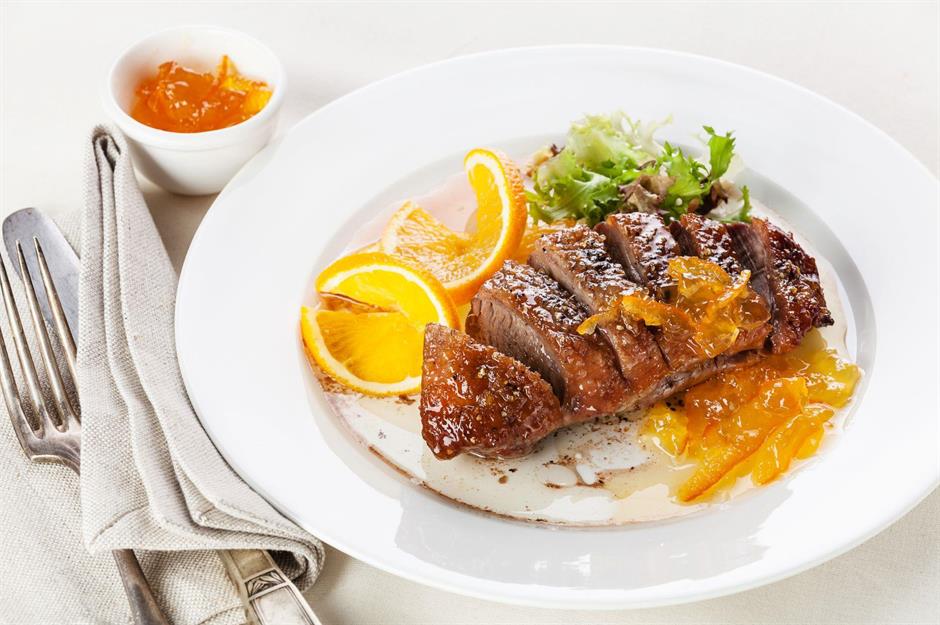
Classic French dish duck à l’orange was considered the height of sophistication in the 1960s, when TV chef Julia Child brought it to the attention of US and UK gourmets. A taste bud–tingling combination of sweet, sour and savoury flavours, it's a dish that not only tastes wonderful, but can also be plated up prettily – so it's no wonder it became an instant hit at fine dining restaurants. Despite its deliciousness, it's a main course you rarely see on menus these days. Maybe it's time to resurrect the recipe at home?
8. Vichyssoise
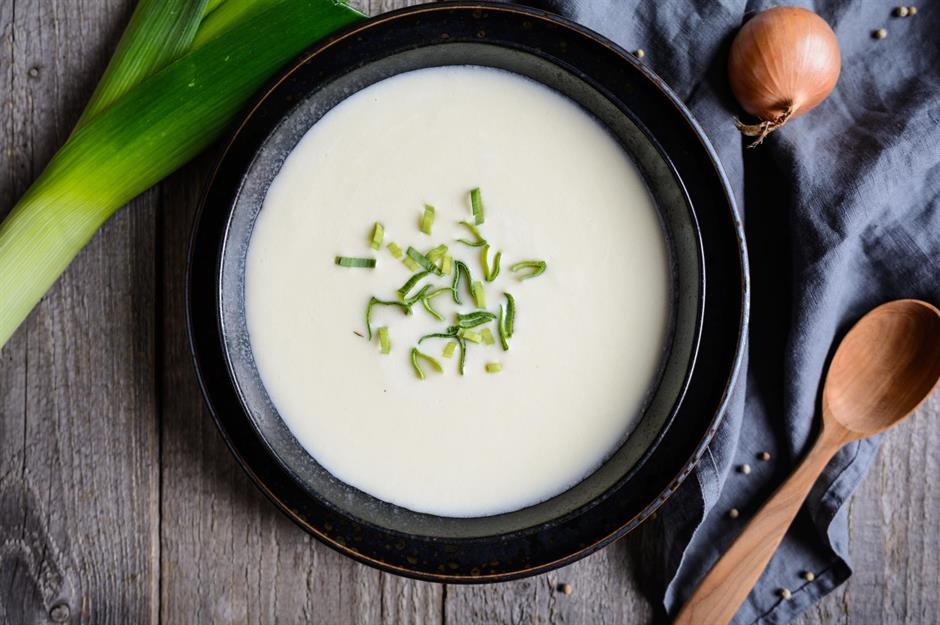
One of the most popular dishes of the 1950s and 1960s was vichyssoise, a chilled soup of leeks, onions and potatoes, blended into a purée with chicken stock and cream. Despite its French name, it’s believed to be an American invention from the kitchen at the Ritz Carlton New York. By the 1970s, it was sold in tins – but its popularity nosedived following a botulism outbreak, in which one person died from a batch produced by Bon Vivant. Regardless of whether tins of the stuff come back into fashion, we think it’s time this refreshing soup was served again.
7. Steak Diane
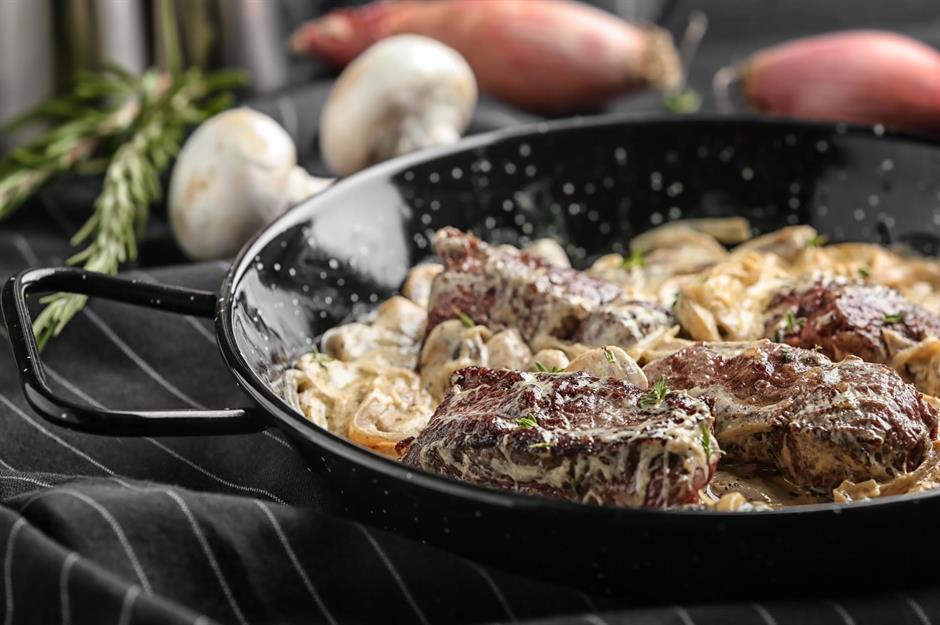
Throughout the 1950s and 1960s, steak Diane epitomised Continental glamour and was one of the most luxurious dishes you could order at restaurants. Dairy and meat had been rationed during World War II, so it was the height of luxury to enjoy butter and beef in the same dish. It was flambéed tableside, and the sauce contained shallots, Worcestershire sauce, Dijon mustard, stock, Cognac and black pepper. The dish fell out of fashion in the late 1970s, but we think it should grace menus once more.
6. Prawn cocktail
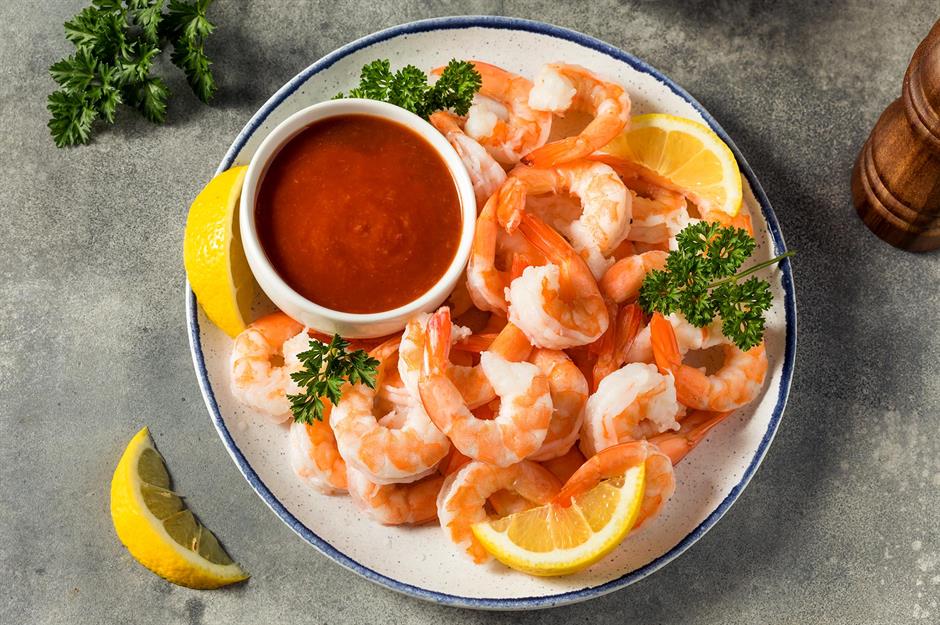
Wildly popular at fancy dinner parties and soirées from the 1960s to the 1980s, prawn cocktails featured a refreshing mix of juicy shellfish, tangy Marie Rose sauce (mayonnaise and ketchup) and lettuce, served with a lemon wedge on the side. Sadly, though, this once ubiquitous hors d'oeuvre fell out of fashion at the turn of the 21st century and has gained a reputation for being somewhat passé. We think it deserves a new lease of life – after all, it's tasty, relatively healthy and looks great, too.
5. Banana split
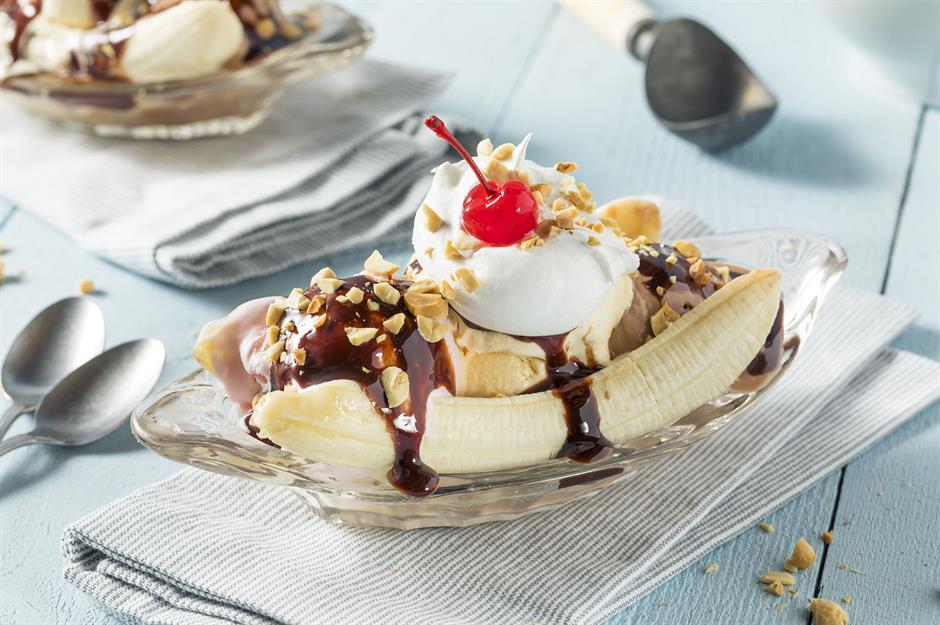
Back in the 1950s, banana splits were all the rage at soda fountains in the US, not to mention restaurants around the world. Tempted by the photo? Here's how to make one: simply halve a banana lengthways, pile on a trio of vanilla, chocolate and strawberry ice cream, add a sauce of your choice (pineapple, chocolate and strawberry are traditional), then top your creation with whipped cream, chopped nuts and a cherry.
4. Black Forest gâteau

We can't imagine why this gorgeous chocolate cake, complete with layer upon layer of cherries and whipped cream, isn't as popular today as it was back in the 1970s. Known as Schwarzwälder Kirschtorte in Germany, where it was invented, it looks stunning and tastes even better. It's only a matter of time before this one makes a major comeback, surely?
3. Fondue
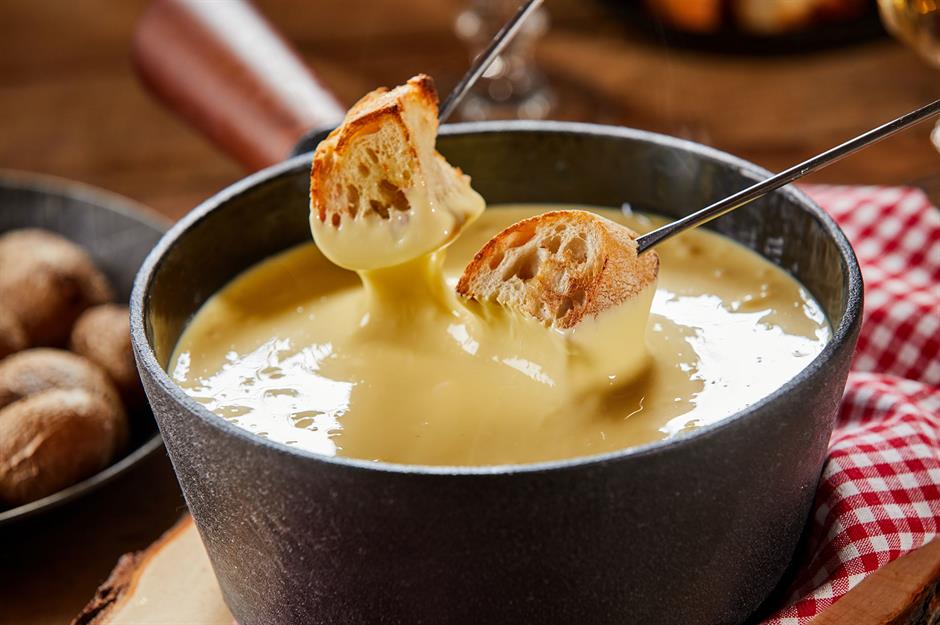
We're not entirely sure why a big vat of molten cheese ever went out of fashion, but we'd definitely like to see fondue back on the dinner table soon – and not just in ski resorts. It makes the perfect dip for chunks of bread, potatoes, leftover roasted vegetables and more. Fondue as we know it dates back to the 1800s, but it was particularly popular in the 1970s. The perfect dessert to follow? Chocolate fondue, obviously.
2. Chicken Kyiv
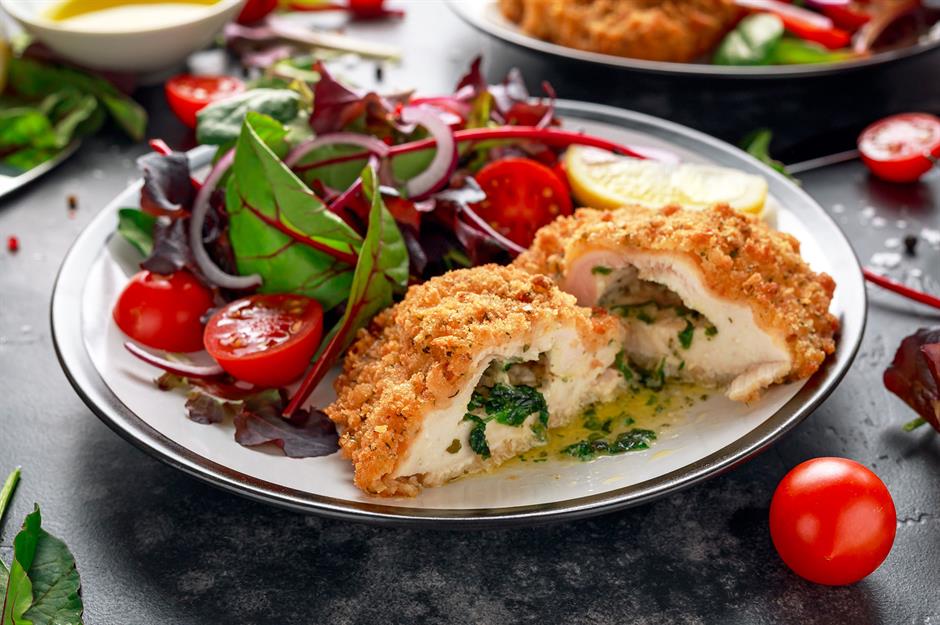
In 2024, a poll of foodies found that chicken Kyiv is one of the most nostalgic dishes for people in the UK. The dish has a long history around the world, of course, but in the UK, it was a dinner party favourite in the 1970s and 1980s. In fact, it was the first ready meal put out by iconic British retailer Marks & Spencer in 1979. To make it, chicken breast is stuffed with a garlicky herb butter, coated in breadcrumbs and fried or baked to perfection. The dish has been out of fashion for so long now that it's surely due a comeback.
1. Baked Alaska
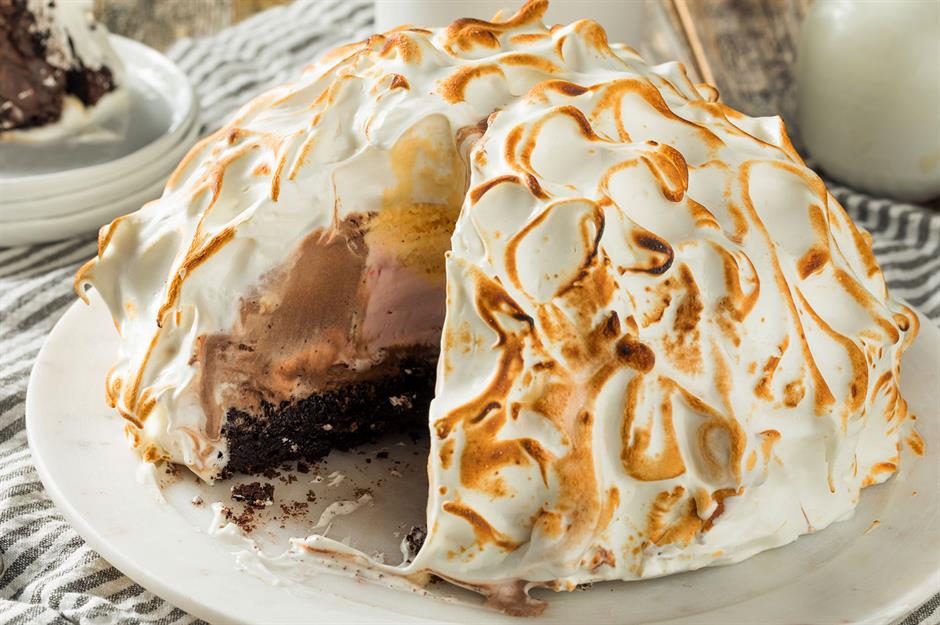
Contrary to what you may think, baked Alaska was actually invented in New York. Famous NYC haunt Delmonico's created the dish to celebrate Alaska becoming part of the United States in 1867. And here's another fun fact: it was originally called 'Alaska, Florida' because it has both hot and cold components. The fabulous dessert is out of style now, unfortunately, but it's an extravagant showstopper that would wow guests at any party.
Now discover the old-school ingredients we think are due a revival
Last updated by Lottie Woodrow.
Comments
Be the first to comment
Do you want to comment on this article? You need to be signed in for this feature